 |
[ Outlaw Genealogy | Bruce
History | Lost Chords ] [ Projects | News | FAQ | Suggestions | Search | HotLinks | Resources | Ufo ] |
 |
[ Outlaw Genealogy | Bruce
History | Lost Chords ] [ Projects | News | FAQ | Suggestions | Search | HotLinks | Resources | Ufo ] |
Still tracking down an Outlaw's QEI's Star Chamber - see: Isle of Ely - Outlawe - Templar Priory monks
Queen Elizabeth I in Norfolk 1578 - Star Chamber - Woodhouse vs. Outlawe
1578 - Queen
Elizabeth I journeys to and from Norfolk in 1578 - Roger
Wodehouse and his wife Mary Corbet were hosts to Queen Elizabeth I at
their fortified and moated house, Kimberly Tower
1578 - Henry
Woodhouse - Roger Woodhouse made Knights by the queen
This seems to be the root of the dispute - The leaders of Lynn gave
Woodhouse the run-around - but why was Outlawe later singled out? :
1578 - Henry
Woodhouse, vice-admiral of Norfolk and Suffolk v Chr. Grante, mayor of
Lynn and others the aldermen, for neglecting to aid the admiral to seize two
ships in the Haven of Lynn until the title to the said ships should be decided, and
for their stubborn answers, that they would neither aid nor resist. Fleet and £100
fine. 20 El.
1578-1579 - Woodhouse v. Outlawe - Court of Star Chamber: Proceedings, Elizabeth I - 21 Eliz - So was an Outlawe an Alderman of Lynn at the time?
Also - So who was Bate ? :
1578-79 - Woodhouse
v. Owtelawe - Court
of Star Chamber: Proceedings, Elizabeth I - 21 Eliz
1578-79 - Woodhouse
v. Bate and Owtlawe - Court of Star Chamber - 21 Eliz
1588 - Sir Roger Wodehouse dies
| - - - - - - - -
"Chr Grante" is apparently "Christopher Gaunt" - he was the mayor of Lynn in 1575 according to this website:
Mayors Kings Lynn during the reign of Queen Elizabeth I - 1559 to 1602 - 1575 - Christopher Gaunt
1578 - 16 Aug 1578 Queen
Elizabeth I lodged at Bishop's Palace in Norwich until 22 Aug
1578 - 22 Aug 1578 Sir
Nicholas Bacon knighted by Queen Elizabeth in Norwich
The manuscripts of the corporations - Great Britain. Royal Commission on Historical Manuscripts, John Cordy Jeaffreson, Southampton (England),
King's Lynn (England)
6 August 1578.—At this daye Mr Mayor, aldermen and comen councell have condiscended and agreed that, where the Quenes Majestie ys nowe comyng into the Countie of
Norfolk, in progress, that (to thintent to sheawe there dutifull obedience and good wills) a present shal be gevin and presented to her Majestie of one hundred Angellz yf yt shall so be thought mete and convenient by the Erle of Leycester, beinge Highe Stewarde of this towne, and Mr Recorder, towardes the performance whereof there was delivered to Mr Maier xlv li. x s. of the comen treasour of this Town.
I actually tried to order copies of the documents (no response) - anyone with access please make pdf's or images and send them to me!!!
Record Summary
Scope and content Woodhouse v. Outlawe Covering dates 21 Eliz
Held by The National Archives, Kew
Visit us The National Archives - ruskin avenue, richmond - The National Archives (United Kingdom)
The National Archives The Catalogue Full Details STAC
Custodial history - On abolition of the Court of Star Chamber in 1641, the court's proceedings up to 1625 were deposited in wainscot presses in the Star Chamber itself. The proceedings of the reign of Charles I, along with decree books, entry books, titling books and calendars were in the Star Chamber Office, situated in the Holborn Court of Gray's Inn. The latter have failed to survive, but their precise fate is as yet undiscovered. The records stored in Star Chamber were moved to the Chapter House at Westminster after the court's abolition. A report to the of Lords in 1719 noted that these documents were 'in a very great heap, undigested, without any covering from dust, or security from rats and mice'. The records were transferred from the Chapter House to the PRO between 1852 and 1860.
If you cannot find what you are looking for online, you can visit us in
Kew to see original documents or records on microfilm or microfiche. Entrance
to The National Archives is free and there is no need to book.
Where to find us The National Archives
| - - - - - - - -
But what I am interested in today is the Wodehouse fortified and moated house, Kimberly Tower:
Also known as, or recorded in historical documents as; Kimberley Hall
In the civil parish of Kimberley. In the historic county of Norfolk (Modern Authority of Norfolk; 1974 county of Norfolk).
Wodehouse Tower, Kimberley has been described as a probable Fortified Manor
House.
There are masonry footings remains.
Ruins of a moated house in Kimberley Park.
It was quadrangular in plan with flanking turrets, a tower and chapel, constructed circa 1400 and demolished before 1659.
Field investigations in 1973 found the house surviving as a ruin, the walls to a height of 1 metre, situated within the earthworks of a moat. To the south was a hollow way which extended north to east through an area of minor desertion, into a complex of fishponds. The house stood at the southern end of the moated island. The northern section of the island would have contained either a garden or a second courtyard with outbuildings. (PastScape)
Norfolk archaeology - Norfolk and Norwich Archaeological Society Vol 15-16
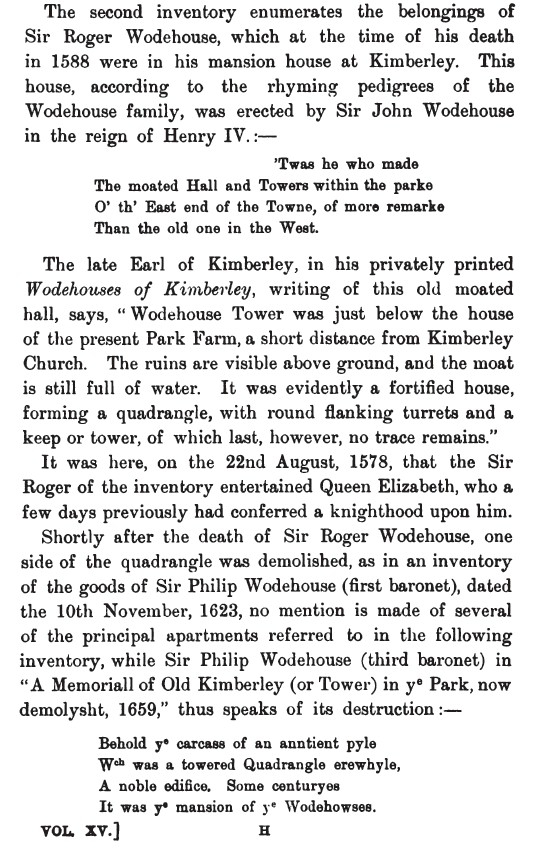
Excursions in the county of Norfolk Volume 2.. - Thomas Cromwell
The family of Wodehouse, which has long been settled in Norwich, derives its descent with little interruption through a succession of knights from the time of Henry I. In that reign Sir Constantine Wodehouse married Isabel, daughter and heiress of the Botetorts. John Wodehouse was a gentleman of the privy chamber to Henry V., and attended that monarch into France. At the battle of Agincourt he so much distinguished himself, that the king granted him an augmentation to his arms, with leave to bear as a motto, Agincourt," and appointed him steward of the Duchy of Lancaster, in the county of Norfolk, with a salary of ten pounds per annum. Sir John Wodehouse, having represented Norfolk in two parliaments, was created Baron Wodehouse, in 1797.
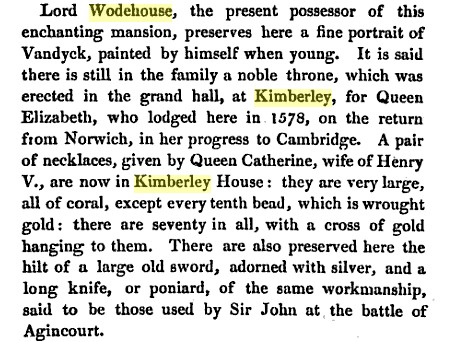
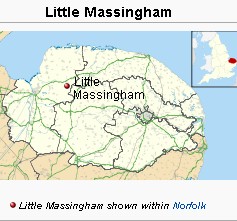 Little Massingham
- is a small village
and civil
parish in the English
county of Norfolk.
It is located on the northern boundary of Great
Massingham. For the purposes of local government, it falls within the district
of King's
Lynn and West Norfolk.
Little Massingham
- is a small village
and civil
parish in the English
county of Norfolk.
It is located on the northern boundary of Great
Massingham. For the purposes of local government, it falls within the district
of King's
Lynn and West Norfolk.
At the time of the Great Survey in 1086, William the Conqueror bestowed upon Eudo, the son of Spiruwin, the Barony of Tateshale in Lincolnshire (now known as Tattershall). William also gave him the lands of Hillington, Grimston, Congham and Little Massingham that had belonged to Scula. Scula is thought to have been a general who served under Viking King Ragnald.
[ well that goes back to Saxon King Edward - so that what we are talking about is a descendent of "Scula" - Ragnald divides Cuthbert’s lands between Scula and Onlafbald [c.915]. ]
In 1302, these lands passed into the possession of Sir John de Thorpe, by right of his wife, Alice.
Someone wrote a book about it:
Massingham Parua past and present - Ronald Fisher McLeod
For nearly three hundred years, the history of East Anglia consists principally of internecine war; and, at the end of that period, the Danes appeared upon the coast. For two hundred years, these fierce barbarians of the north were the terror and the scourge of the Saxons; and ever when the Danish flag, bearing the representation of a Raven, was seen over the waves that beat towards England, it was the sure omen of burning dwelling-houses, of pillaged monasteries, and of a fugitive or slaughtered people.
A contemporary writer pathetically describes the condition of the Angles. He says, "Such is the Danes' valour that one of them will put ten of us to flight: two or three will drive a troop of captive Christians from sea to sea. The slave of yesterday becomes the master of his lord to-day. Soldiers, famine, flames and blood surround us.
The poor are sold out of their land for foreign slavery. Children in their cradles are sold for slaves, by an atrocious violation of the law."
The misery and wretchedness of the inhabitants of the land continued until the Monarch ascended the throne, of whom the Saxon poet sang :—
"Here ended his earthly joys Edgar, England's King,
And chose the light of another world, beauteous and happy:
Here Edgar departed—the Ruler of the Angles,
The Joy of the West Saxons, the Defender of the Mercians—
That was known afar among many nations:
Kings, beyond the baths of the sea-fowl, worshipped him, far and wide,
They bowed to the King, as one of their own kin.
There was no Fleet so proud, there was no Host so strong,
As to seek food in England while this noble King ruled.
He reared up God's House, he loved God's laws,
He preserved the people's peace: the best of all the Kings
That were before in the memory of man.
And God was his helper ; and Kings and Earls bowed to him,
And they obeyed his will; and, without battle,
He ruled as he willed."
...
[ It is interesting that the Isle of Ely area was left relatively alone until Hereward's revolt 1070 after the rebellion of York and Harrying of the North.]
In the reign of Edward the Confessor, Harold, Earl Godwin's son, owned a manor in Great Massingham, part of which extended into what is now Little Massingham. Another part of Little Massingham, and also the Manor of Anmer, were the property of a Saxon freeman, named Orgar. A very large estate extended from Hillington, through Congham and Grimston, into the western part of Little Massingham, and was the lordship of another freeman named Scula.
For some years after the death of Harold at Hastings, West Norfolk enjoyed its independence ; and Orgar and Scula, among the thanes and ceorls of the County, acknowledged no superior, paid no tribute, and continued to manage their estates and govern their vassals according to the example of immemorial custom.
But when the Conqueror's ships appeared in the Wash, and William himself was marching at the head of his forces from Cambridge to Ely, in order to storm Hereward's impregnable natural fortress, the day of independence for the Saxon gentlemen of West Norfolk was drawing to a
close. With the treacherous betrayal of Hereward, their last hope of immunity from foreign oppression disappeared, and
William's soldiers soon after burst into the County, plundering and firing homesteads as they went, and putting to the sword all who dared withstand them.
I knew about this but didn't have the document: Utlag as a Danish/Viking origin... The "Ostmen"
1051 - In October Godwin and the rest of his sons were declared outlaws and given five days to leave the country. The men of Dover were left unpunished. Godwin, his wife Gytha, and his sons Swein, Tosti and Gyrth boarded ship at Bosham and left for Flanders. Harold and Leofwine Godwinson sailed from Bristol for the Norse stronghold of Dublin in Ireland.
1171 - The people of Bristol were given Dublin as a colony by the king and many Bristolians settled there. Charter was issued by Henry II in 1171-1172, giving the men of Bristol the right to live in the City of Dublin. Later charters contain grants to the city of rights, privileges and property
1180-1199 - Torsten Utlag - Burgess - Dublin Ireland - In the earliest burgess roll of Dublin, which dates from about the end of the twelfth century, out of many hundreds of names only three seem to be of Norse origin; these are Cullin filius Seafani, Torsten utlag, and Turstein filius Simundi
The English historical review, Volume 23 edited by Mandell Creighton
The English and Ostmen in Ireland
AS is well known, the adventurers of Norman and English blood who landed in Ireland in the years 1169-1170 found themselves confronted not only by the Celtic natives, but also by a race who, like themselves, were Teutonic in blood and as colonists and invaders had preceded them by but a few hundred years. These were the descendants of Norwegian and Danish settlers who had blended now into a race, called by the generic name of Ostmen, both among themselves and by the English.1 This race was practically an urban one.
The Ostmen held five cities which they had
founded, and within whose walls they lived the lives of merchants, sometimes
varied by acts of piracy, those cities being Dublin, Waterford, Limerick,
Wexford, and Cork. . The first three were governed by petty kings, but it is
uncertain whether the last two had dynasties of their own. Yet their colonies
were not exclusively urban. The Dublin Ostmen had
an indefinite rule and colonies extending over a district roughly corresponding
to the modern county Dublin, stretching west to the modern Leixlip, the name
of which indicates in Norse' Salmon-Leap,' south to Wicklow, and north over
a much wider area extending to the borders of Meath, called by the Irish
themselves Finegall, or ' boundary of the foreigners.' The whole formed a small
kingdom, called in the Icelandic Landnamabok 'Dyflinarski.' Waterford, a walled
city
...
The circumstances of the conquest of these towns are well enough known. It is
sufficient to say that by the year 1200 all of them were in the hands of the
English. What now happened to the Ostmen? It
is probable that of this powerful and numerous race the greater part sailed off
to the free Norse-land which remained in Man and the Scottish islands. Others, perhaps,
went over to England to practice maritime trades. The pilots of the English
seaports are called Esturmanni in the documents of the thirteenth century. This
itself is most certainly a Scandinavian word, implying ' steersmen,' and
the pilots were probably mainly of Northman stock.2
Here then was an occupation to which many of the Ostmen could
turn. Those who remained were in the main practically excluded from those
privileges, legal and commercial, which the English brought with them, though
they received some favour not shown to the Irish.
The advantage to the English colonists of treating the older race as outlaws
is obvious. They were the better enabled to do this successfully because, to the
superficial eye of the law, the Ostmen were hard
to distinguish from the rightless Irish. Separated from the great Norse world,
few in numbers, the original Norsemen of Ireland had become in the course of
three centuries more than half Hibernicised. It is evident that intermarriage
between Irish kings and Dublin or other Northman princes had been complicated
and numerous during the tenth and eleventh centuries, and the advantage was all
on the side of the natives.
...
A further feature of the treatment of the Ostmen was
their exclusion from gilds and burgess rights. As we see the numbers of this
people must have been considerable, considering how few at first the English
themselves probably were. In Waterfond Philip mac Gothmond had ' 400 of his
race' about him. In the early part of the thirteenth century there were in the
county Wexford a hundred freeholders of this race, with their families; and yet,
if we went by burgess rolls only and lists of the members of gilds, we should
be almost left ignorant of the existence of a surviving Ostman race. It is
clear that the English townsmen at once rigorously excluded these born traders
from all participation in gild and borough rights.
In the earliest burgess roll of Dublin, which dates from about the end of the twelfth century, out of many hundreds of names only three seem to be of Norse origin; these are Cullin filius Seafani, Torsten utlag, and Turstein filius Simundi
T.R.E. = Tempore Regis Eduardi (Latin for in the time of King Edward), much used in the Domesday Book (1085-1086) and meaning the period immediately before the Norman conquest of England
T.R.W. = Tempore Regis Willelmi ("in the time of King William"), Latin term used by scholars to refer to arrangements mentioned in Domesday Book which were current during the reign of William the Conqueror (r. 1066-1087), as opposed to TRE (Tempore Regis Eduardi).
Here we can show that the early Utlag's may have originally been from East Anglia and may have been of the Wuffings (Geatish/Swedish origins) or Viking Danish....
By the time of King Edwy and King Edgar the Utlag's may have been politically connected to the land of East Anglia which was now an earldom . ...
869 - Wuffing
King Edmund is martyred by the Danes near Thetford - Last
of the Wuffing Kings
920 - Edward the Elder
takes East Anglia from the Danes
957 - Outlawe(s) Banished
for political offences to Ireland by King Edwy - St. Dunstan Banished -
1613
Visitation Legend
A history of Norfolk - Norfolk before the Normans.
This has moved to Hereward the Wake - Outlawe
Connected to the above, and in association with Hereward the Wake, among his companions "the Outlaw" we have this:
... Turkillys, and Utlamhe, that is The Outlaw, ...
Thurkill = Thorketel = Turchetil = Turkillys
Asketil = Ascytel
...
This content has moved to : Hereward the Wake - Outlawe
...
A few fragmentary remarks about 1066 are to be found in sources which
predate the monastic versions of the Anglo-Saxon Chronicle which I have been
discussing, and those which reflect the English point of view, are bleaker
still.
The earliest such source is the Life of King Edward, written at the
request of his wife Queen Edith in the years 1067.
The queen lost three of her brothers in the battle of Hastings and her mother
Gytha and other relatives were obliged to flee to Flanders to escape the wrath
of the Normans, yet the battle is only hinted at in the Life.
Life of King Edward the Confessor
 Cambridge
University Library MS. Ee.3.59 contains the only copy of an illustrated
Anglo-Norman verse Life of St Edward the Confessor, written in England
probably in the later 1230s or early 1240s, and preserved in this manuscript,
executed c. 1250-60.
Cambridge
University Library MS. Ee.3.59 contains the only copy of an illustrated
Anglo-Norman verse Life of St Edward the Confessor, written in England
probably in the later 1230s or early 1240s, and preserved in this manuscript,
executed c. 1250-60.
Summary of pages with descriptions
Introduction to the Manuscripts
Vita Ædwardi Regis
- The Vita Ædwardi Regis qui apud Westmonasterium Requiescit ("Life
of King Edward who rests at Westminster") or simply Vita Ædwardi Regis
("Life of King Edward") is a historical work completed by an anonymous
author c. 1067 and commissioned by Queen Edith,
wife of King Edward
the Confessor. It survives in one manuscript, dated c. 1100, now in the British
Library. The author is unknown, but was a servant of the queen and was
probably a Fleming.
The most likely candidates are Goscelin
and Folcard, monks
of St
Bertin Abbey in St
Omer.
...
There are two modern editions, those of Henry
Richards Luard (1858) and Frank
Barlow (1962, 1992).
...
Historian Frank Barlow characterised the dating of the Vita as
"relatively simple" in comparison with other texts of the era.[7]
The latest event to be referred to in the text is the Battle
of Hastings of 1066, and the work as a whole must have been completed
before the death of Queen Edith
and deposition of Archbishop Stigand,
1075 and 1070 respectively
Domesday - Prosopography of Anglo-Saxon England
Frank Barlow Obituary Books The Guardian
The Life of King Edward Who Rests at Westminster by Frank Barlow
Two Early Englefield Deeds by Fred Turner
This is interesting in that 1670 Capt. John Outlaw disappears with a nice 14 foot boat worth 700 pounds of Tobacco ...
Maybe we can glean something from the colonists the Outlaw's must have associated, and been with, in early North Carolina....
ABSTRACT OF RECORDS.
(Complied from the office of the Clerk of the Superior Court of Chowan County, at Edenton, N. C.)
Att a called Court, held the 15th July, 1670, at ye house of Samuel Davis, for ye county of Albemarle, in ye Province of
Carolina. Present, the Honorable Peter Carteret, Governor and Commander-in-Chief. Left, Col. John Jenkins, John Harudy, Major Richard Foster, Capt. Thomas Cullen, council. Whereas,
Mr. John Culpeper, Gent, attorney for Sir Wm. Berkeley, Knight, and Capt. General of
Virginia, petition to this Court for letters of administration on ye estate Capt. Sam'l Stephens, deceased, he putting in security to save ye Court harmless, it is ordered yt ye said Culpeper have orders of
administration granted to him.
...
At a Generall Court, held ye 27 September, 1670, at ye house of Sam'l Davis, for ye county of Albemarle, in ye Province of Carolina. Present, the Honorable
Peter Carteret, Esq., Governor and Commander-in-Chief. Left, C ,1. John Jenkins, Mr. John Harudy, Mr. Oliver Rithd. Foster, Mr. Francis Godfrey, Mr. John Willoughby, Capt. Thomas Cullen.
...
John Outlaw, against Sam'l Pricklove.
Capt. Cath Cone, against Jo Outlaw
...
John Burrows, petition to have an attachment against ye estate of John Outlaw; there appears due to him 200 lbs tobacco.
...
Laurence Gunfallis, obtained an order against Capt Jo Outlaw, in May Court, 1670, for a bote of 14 foot, and whereas said Outlaw is departed from his house, and there can be no boat
had, Mr. Herman Smewin, and Abraham Ivimberly, were sworn in Court, to appraise ye worth of ye said bote, who vallowed said
boat to be worth 750 lbs tobacco, and cost, and cost of sale, wherefore, it is ordered yt said Gunfallis satisfy his debt out of ye said Outlaw's estate, where it can be found.
Tes. Peter Carteret, Sec.
...
Samuel Davis against Jno. Outlaw; 1672.
March 27, 1680. Ordered that Samuel Pricklove stand in the pillory three hours, and loose his right ear, and be banished this county for ever, and to live in prison without bayle in yrons, or otherwise, until hee shall bee shipped for his transport, and their aboard kept in yrons, till at his place he be landed with costs and fees.
1826. Outlaw, Elijah and Mary Welch. Jan'y
4th. William Moore.
...
In Ancient Albemarle - Chapter 1
WIKACOME IN WEAPOMEIOK, THE HOME OF GEORGE DURANT
In Perquimans County, North Carolina, there lies between the beautiful Perquimans River on the west, and her fair and placid sister, the Katoline or Little River, on the east, a lovely strip of land to which the red man in days long gone, gave the name of Wikacome. The broad sound whose tawny waters wash the southern shores of this peninsula, as well as all that tract of land lying between the Chowan River and the Atlantic Ocean, were known to the primitive dwellers in that region as Weapomeiok.
Not until George Durant came into Carolina, and following him a thin stream of settlers that finally overflowed the surrounding country, did the beautiful Indian names give place to those by which they are now known. Then Wikacome became the familiar Durant's Neck, and the waters of Weapomeiok and the territory known to the aborigines by the same name, changed to the historic cognomen of Albemarle.
George Durant and Samuel Pricklove were the first of the
Anglo-Saxon race to establish a permanent settlement in Wikacome, though
they were not the first Englishmen whose eyes had rested upon its virgin forests
and fair green meadows, for in the early spring of 1586 Ralph Lane, who had been
sent with Sir Richard Grenville by Sir Walter Raleigh to colonize Roanoke
Island, set out with fourteen comrades from that place on an exploring
expedition, hoping to find the golden "Will-o'-the-Wisp," which led so
many English adventurers of the day to seek their fortunes in the New World.
...
In 1630 Sir Robert Heath, to whom Charles I granted a large portion of
Carolina, attempted to establish a settlement in the territory. Later Roger
Green, an English clergyman, made a similar attempt near the present town of
Edenton, but both these efforts failed. However, the spirit of discovery and
adventure was now fully aroused, and by 1656 a number of settlements had been
established along the shores of the streams that flow into Albemarle Sound.
Of none of these, however, can any accurate account be given, their date and
location having long been forgotten ; and not until 1661 is there any
authenticated record of a permanent settlement in North Carolina.
...
With the establishment of George Durant on the peninsula now called by his name,
the connected history of North Carolina begins... The deed for this tract of
land is now in the old court-house in Hertford, North Carolina, and is the
earliest recorded in the history of our State.
March 1661 -
"Know all men these Presents that I, Kilcokonen King of the Yeopems have for a valuable consideration of satisfaction received with ye consent of my People sold and made over and delivered to George Durant, a Parcel of land lying and being on a river called by ye name of Perquimans, which issueth out of the North side of the aforesaid Sound, and which land at present bears ye name of Wecameke. Beginning at a marked oak tree which divideth this land from ye land I formerly sold Samuel Precklove and extending easterly up ye said Sound at a point or turning of ye aforesaid Perquimans River and so up ye east side of ye said river to a creek called Awoseake to wit, all ye land between ye aforesaid bounds of Samuel Precklove and the said creek whence to ye head thereof. And thence through ye woods to ye first bounds. To have and to hold ye quiet possession of ye same to him, his heirs forever, with all rights and privileges thereto forever from me or any person or persons whatsoever, as witness my hand this first day of March 1661.
... George Durant was in Northumberland (later Westmoreland) County,
Virginia by 1650 or before. He would have been about eighteen years old in 1650.
By trade, Durant was a "marriner" - as attested in his will
dated 9 Oct 1688. The earliest sailing voyage that is documented for George
Durant was in 1658, when he sailed aboard the Patomack Mecht, commanded
by Robert Clarke. Young George Durant was about twenty-five years old at the
time. The Patomack Mecht was possibly of Dutch construction and sailed
from Virginia to Holland with a cargo of tobacco and other goods. We know of
this voyage because there is a court case associated with the thirty hogsheads
of tobacco stowed on board
...
In the year of 1658, he joined a party composed of John Battle, Dr. Thomas Relfe,
Roger Williams, Thomas Jarvis, John Harvey, John Jenkins and others to explore
and settle the wilderness of the Albemarle - which was then a frontier of
Virginia called Roanoke
...
The land chosen by Durant still bears the name of Durant's Neck (formerly
known as Wikacome) and is located on a point of land bordered by Roanoke
Sound (now Albemarle Sound) in southern Perquimans County. Perquimans means
"land of beautiful women" and was named by the Yeopim Indians.
...
By 1662, Durant had already built a house and had cleared a part of the
land.
A year later, the governor of Virginia (Sir William Berkeley) told all settlers who had obtained land from the Indians that they must now obtain grants from Virginia.
...
To circumvent the Navigation Acts, Albemarle merchants began smuggling. The New England coastal traders opened a profitable illegal trade with the Carolina planters. Tobacco was carried by sloop to Boston. From there it was transported to heavy ships bound for Scotland, Ireland, Holland, France, and Spain. England quickly caught on to the fact that they were losing valuable customs revenue and retaliated by passing the Plantation Duty Act in 1673. This act stated that colonial ships leaving port had to pay customs duties prior to sailing. Parliment appointed customs officials in Albemarle to collect the duties
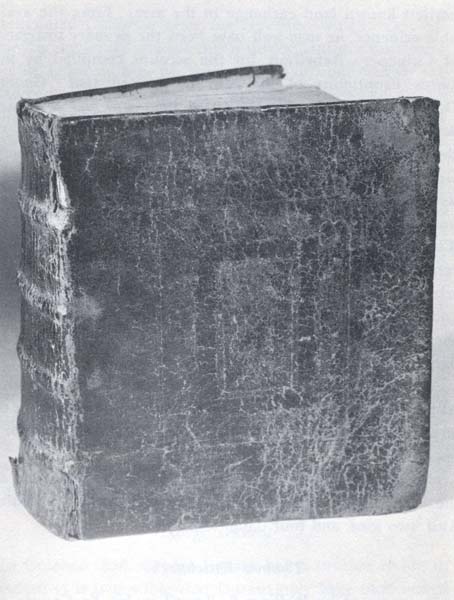 The
Durant Family Bible is one of the oldest English Bibles in the USA. It
is displayed at the University
of North Carolina at Chapel Hill in a locked cabinet. The Bible was printed
in London, England in 1599. He brought this Bible with him when he came to the
New World.
The
Durant Family Bible is one of the oldest English Bibles in the USA. It
is displayed at the University
of North Carolina at Chapel Hill in a locked cabinet. The Bible was printed
in London, England in 1599. He brought this Bible with him when he came to the
New World.
| - - - -
Quaker leader Samuel Pricklove, one the Albemarle's earliest inhabitants
Quaker Communities in Albemarle
On February 6, 1665, the first group of six freeholders met beneath a giant oak tree on the
banks of Hall's (Hill's ?) Creek in Pasquotank Precinct1 to organize community affairs. William
Drummond, one of those present at that meeting, had been appointed the first Governor of
Albemarle in 1664 by Gov. Berkeley, acting on orders of the Lord Proprietors. George
Catchmaid of Perquimans was chosen Assembly Speaker.2 Samuel Pricklove and George
Durant were probably also among the original six at the meeting. Both served as local officials
and were the first two settlers of the area. The isolation of Albemarle and the independent
nature of it's people were factors contributing to unstable government in the young colony in its
first years of existence.
...
Samuel Pricklove was one of the first residents of Perquimans Precinct, arriving even before
settler George Durant, in 1662. 5 Pricklove was the first known purchaser of Indian lands in
Albemarle and held a grant from Governor Berkeley of Virginia for a large tract on the
Perquimans River near Durant, where the two men became life-long friends.
...
Pricklove held the offices of Registrar of deeds and Clerk of the Inferior Court under the administrations
of two early Quaker Governors of Carolina in the 1650’s: Governor William Drummond (executed by Governor Berkeley in Bacon's Rebellion) and Governor Archdale.6
Both Pricklove and Durant took part in the Culpepper Rebellion of 1677 and assisted in "leading the rabble" to
depose the Deputy Governor Thomas Miller. For this crime of activism, Pricklove was
sentenced to have his right ear amputated and be banished from the colony.
The sentence was never carried out because Miller was deposed. Samuel Pricklove died in Perquimans
County in 1692. He and his wife left two sons, Samuel and John. John Pritloe and his wife,
Elizabeth, had six daughters, all of whom married men of substance and influence in
Albemarle:
• Priscilla married John Sanders
• Judeth married Abram Sanders, son of John Sanders of Virginia
• Rachel married Robert Wilson, son of a Virginia Burgess
• Elizabeth married William Elliott
• Rebecca married Zacariah Chancy
• Leah married Joseph Smith. Leah and Joseph Smith were the grandparents of Mary
Smith, wife of William Hill. John Smith, brother of Mary Hill, was one of the founders of
Richmond, Indiana. Basil Sanders, who left 860 acres of land in Chowan County to a William
Hill of Antigua in 1721, was likely the son of one of the above Sanders couples.
| - - - -
Capt. Cath Cone, against Jo Outlaw
Early N.C/ Capt Cath Cone
I knew I had seen this name somewhere, and it was from Grady, but the two
times I found it in the files there is nothing about Capt. Cath. Cone in the email. Well, today the last of my Summer ILLs arrived from the D.H. Hill
Library at NC State, and there he was. (D.H. Hill BTW was a CSA General who is
buried in the town cemetery in Davidson, NC right across the street from the college.)
Capt. Cath. Cone appears on p. 568 (the book starts on p. 559) of Worth S. Ray's _Old Albemarle and its Absentee Landlords_ published by Genealogical
Publishing Co., Baltimore, in 1968. Originally it was published a Part IV of
The Lost Tribes of North Carolina_, Austin, 1947.
Ray sites documentary evidence that Capt. Cath. Cone attended the Albemarle
Court in 1670 and says that details can be found on p. 27 of the original.
He says that all those on the list are of great historical
significance, but without Part I where page 27 must be, I can't guess. That's 20 years before
Neale Macone's widow remarried in Isle of Wight Co., VA.
Anybody have anything on this bird? Anybody have the first 3 parts of the
original book? What is "Cath." an abbreviation for?
Persons Attending Albemarle Court - 1670
John Barrows
John Jenkins
Robert Bono
Abraham Kimberly
Gov. Peter Carteret
William Lewerton
Edmund Chancey
Thomas Matkie
Capt. Cath. Cone
Robert Minty
Capt. William Crawford James Nokes
Capt. Thomas Cullen
John Outlaw
John Culpepper
Robert Risrod
Samuel Davis
Thomas Sharpman
John Dye
James Shrewsbury
Thomas Easthurt (Eastchurch) William Simons
Richard Felton
Thomas Simons
Maj. Richard Foster
Anthony Slocum
Francis Godfrey
Herman Smewin
Lawrence Gunfallis
Hugh Smithwick
Hurtulus Gun
Nicholas Stevens
John Hardy
Katherine Williams
Edward Haswell
Roger William's Widow
John Hawkins
John Willoughby
John Hill
Andrew Woolward
Thomas Hoskins
William Voss
Will Jackson
| - - - - -
Manhole Music Tea Room History Nerd Nirvana - Saturday, April 05, 2008 - posted by suleyman
My tenth great uncle, Captain John Outlaw, was a wild ass of a man.
For the brief time he was in the New World, he was a hell raiser and a
ne'er-do-well. The surname "Outlaw" or "Outlawe" would
suggest that he was some sort of pirate, but the Outlaw name had been around for
some time in England, and wasn't associated with piracy or banditry. Scholars
seem to think it had its origins in an individual or group of individuals who
had been excommunicated by the Church or deprived of the right to plea in a
court of justice due to a dispute with the Crown. The exact origins of the name
aren't clear, nor the decision to adopt and perpetuate it, but as early as the
13th century it was in use as a surname.
John came to Virginia around 1667 or 1668 with my 10th great grandfather, Edward
Outlaw, who at that time was only about 18 or 19. John was older than Edward,
although I'm not sure by how much, he was probably in his mid 20s. They settled
on the western branch of the Elizabeth River near modern day Suffolk, and did
what most men did in Virginia in the middle of the 17th century, grow the vile
Virginia weed. Virginia was full of men seeking their fortune in the cultivation
of tobacco, and John and Edward seem to have engaged in that enterprise. In
addition to growing tobacco, John made a living as a boat captain and boat
builder, probably ferrying goods and passengers on the Elizabeth river, hence
the title "Captain."
Not long after arriving, the men seem to have run afoul of the law, which was
common in a society made up primarily of young, single men struggling to
survive, and thinking only of profit. John, Edward, and a minor by the name of
Thomas Forkin were brought to court in May of 1668 for the crime of killing
another man's steer. To me, the crime suggests that the two were probably
hungry, desperate for something substantive to eat, and saw a fat steer wander
onto their property (there were scarcely any fences then, animals just went
where they pleased). Even though John and Edward were probably cultivating
tobacco out the wazoo, they most likely didn't grow much that was edible, which
was common for those early fortune hunters, who lived in a state of near
barbarity. Even the houses they lived in were semi-permanent hovels, bearing a
closer resemblance to an Indian hut than a log cabin. The owner of the steer,
probably one Edward Wesray, sued the Outlaws and Forkin to cover the loss of his
steer, and was awarded 1,000 pounds of tobacco by the court. Another 1,000
pounds was due to the colony, which John was forced to pay for since Edward and
Thomas Forkin were both minors.
But the two didn't keep on their best behavior after that. In August of 1668,
John and Edward were at a neighbor's funeral. While there, John got into an
argument with a man by the name of John Johnson. What this argument was about is
unknown (perhaps the stupidity of John Johnson's name, or perhaps Captain John
was just drunk), but it got so violent that the local constable was sought out
and brought to the funeral to calm things down. Captain John met the constable,
William Dafnell (who is also a relative of mine), at the door and while spewing
a string of epithets that may or may not have involved the words "canker
blossom," he pummeled him repeatedly. "What is the matter with you,
Capt. Outlaw," Dafnell replied, "I have charged the peace before you
and I know not what to doe with you." One witness testified that Edward
became involved in the scrape, but it was John who was brought to court twice
for the incident in 1668 and in 1669 as part of a related suit on the part of
William Dafnell. The great irony of it all is that Edward would later marry
William Dafnell's daughter, Mary. There's an interesting romance there that will
most likely never be told.
The exact result of the trial is unknown, but it is clear that by 1670 John
was a persona non grata in lower Virginia. That year he moved southward into
Carolina, perhaps seeking the greater freedom and anonymity of what was then a
lawless backwater. Edward remained on in Virginia, marrying Mary, and
accumulating a fair amount of property, including slaves. John seems to not have
faired as well as his brother in the New World, but he continued to have some
influence over Edward's behavior. For instance, Edward was fined for not
maintaining the public roads that ran through his property, an infraction that
John had been fined for in the past. But as the two became more geographically
distant, Edward became more of an upstanding Outlaw.
In Carolina, John served as a boat captain and boat builder, and he ran
into trouble for not being the best of businessmen.
A man by the name of Laurence Gunfallis contracted John to build a "bote
of fourteen foot" in 1670, apparently paying him in advance. When no
boat was delivered and John was "departed from his house," Gunfallis
went before the Albemarle County Court to either get his boat or his money back.
The court ruled that the boat was worth about 750 pounds of tobacco, and since John
had apparently skipped town Gunfallis could "satisfy his debt out of ye
said Outlaw's estate where it can be found."
Why had John split? Perhaps after obtaining payment for the construction
of the boat he took the money and ran. But for such a small sum? Perhaps more
likely, John simply could not deliver the boat for whatever reason (he may have
blown the money, Lord knows) and rather than face another court hearing skipped
town. There are no records of him anywhere after 1670, and one
genealogist says it is believed he returned to England, where he lived for the
rest of his life. Perhaps one day, when I finally get to visit England, I will
wander through a Norfolk graveyard and find a stone marked "Cpt. John
Outlawe." That would please me. Edward remained on in Virgina, becoming one
of the earliest (but not THE earliest) of my American ancestors.
Discovering all of this, piecing it together, and now interpreting it is what I
would consider History Nerd Nirvana.
I don't know how this relates to the early Utlags' , but it does seems interesting.
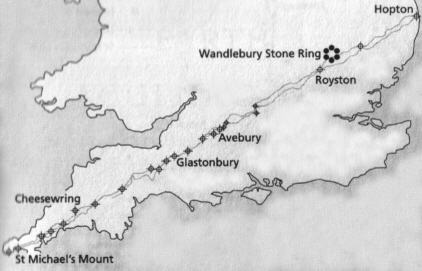
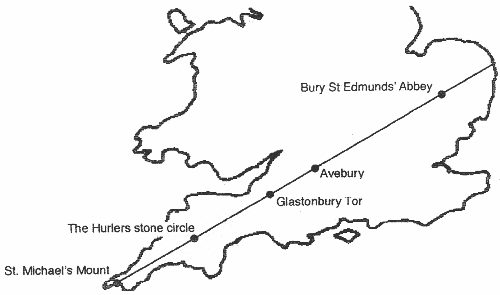
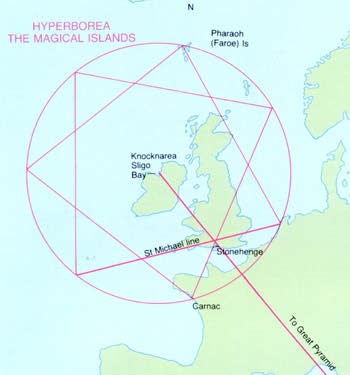
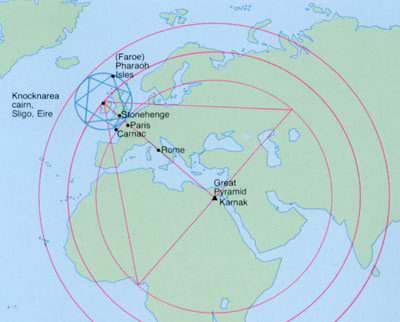
St. Michaels Line also corresponds to one of the oldest roads in England: The Icknield Way
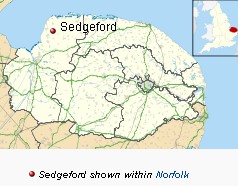 1614 - Owtlawe,
Richard,
of Sedgeford - probate will (This may have been Richard Outlawe the
pursuivant)
1614 - Owtlawe,
Richard,
of Sedgeford - probate will (This may have been Richard Outlawe the
pursuivant)
Sedgeford - it is crossed by two ancient roads - the prehistoric Icknield Way and the Roman-period the Peddars Way. Peddars Way, the ancient Roman road, runs through the top end of the village and leads directly onto the Norfolk Coastal path.
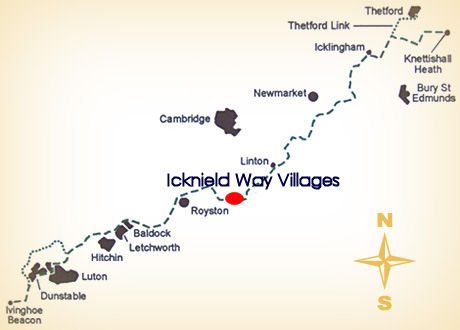 The
Icknield Way - at the very centre of which lies our parish - is one of the
oldest roads in Great Britain, being one of the few long-distance trackways
to have existed before the Romans occupied the country, of which the route can
still be traced. The name is Celto-British in derivation, and may
be named after the Iceni tribe, who may have established this route to permit
trade with other parts of the country from their base in East Anglia. It has
also been suggested that the road has older prehistoric origins.
The
Icknield Way - at the very centre of which lies our parish - is one of the
oldest roads in Great Britain, being one of the few long-distance trackways
to have existed before the Romans occupied the country, of which the route can
still be traced. The name is Celto-British in derivation, and may
be named after the Iceni tribe, who may have established this route to permit
trade with other parts of the country from their base in East Anglia. It has
also been suggested that the road has older prehistoric origins.
However, the name is also said to have been initially used for the part to the west and south (i.e. south of the River Thames) but now refers usually to the track or traces north of the Thames. From ancient times, at least early as the Iron Age period (before the Roman invasion of 43 AD) and through Anglo-Saxon times, it stretched from Berkshire through Oxfordshire and crossed the River Thames at Chosley near Wallingford.
The path is 105 miles long, linking the Ridgeway Path to the Peddars Way. Somewhat confusingly, the name Icknield Way was transferred in the 12th century to a Roman road running from Bourton on the Water to Templeborough near Rotherham. This is now called Icknield Street or Ryknild Street to distinguish it from the older Icknield Way.>
In many places the track consists or consisted of several routes, particularly as it passes along the line of the escarpment of the Chilterns, probably because of the seasonal usage, and possibly the amount of traffic especially of herds or flocks of livestock. At Wallingford, it meets the Ridgeway another ancient trackway, passes in a north easterly direction along the edge of the Chilterns past Ivinghoe Beacon in Buckinghamshire through Bedfordshire, Hertfordshire and Cambridgeshire to Knettishall Heath in Norfolk.
It could be described as a belt studded with archaeological sites found at irregular intervals. Many modern roads follow the Icknield Way, for example the main road at Dunstable that crosses Watling Street (the A5). In some places, especially from the east of Luton to Ickleford (so named from the Way crossing a stream) near Hitchin in Hertfordshire the route is followed by many more minor roads, and is not distinguishable at all in many places, except by landscape features, such as barrows and mounds which line the route, and indentation presumably from ancient and frequent use.
The Icknield Way used to form part of the boundary between Hertfordshire and Cambridgeshire, and at one time Royston was cut in two by this boundary. Royston lies where the Icknield Way crosses Ermine Street.
1319 - Adam Utlagh is mentioned re Bury St Edmund
1341 - Reginald Outlawe of Brunne, rect. of E. H. exchanged in 1341 with Thomas de Eure of Blakolmslee. - Esthattele = East Hatley St. Denis (North of Royston)
Ley Lines of the British Isles
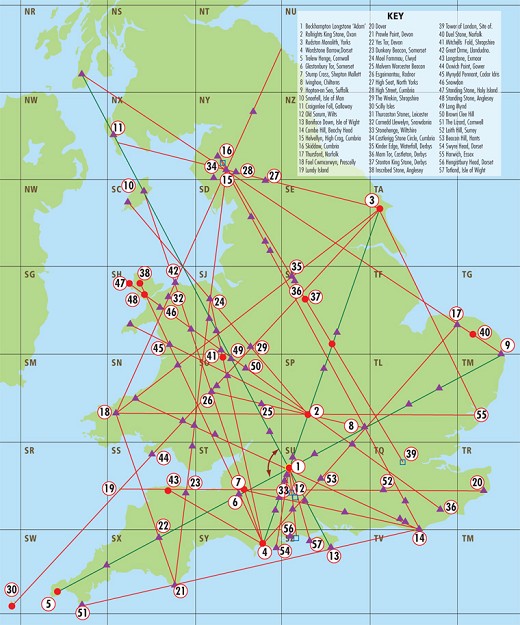
Of interest to me are 17 - 40 - 9
4 - Wardstone
Barrow, Dorset - Round Barrows in Dorset
This barrow is on the chalk ridge just inland from the coast, between the
White Nothe headland and West Lulworth. It was originally one of a pair, but the
eastern barrow has been levelled by farming activity. The mound is 15 metres in
diameter, up to 2 metres high, and the surrounding ditch is mostly infilled. The
mound is now overgrown with gorse and brambles.
The name of this barrow probably comes from the Anglo-Saxon "weard-stān",
meaning stone where watch was kept. The barrow is located in a very prominent
position on the coastal ridge with good visibility all around, over land and
sea. There is no record of a megalith at the site - only of an excavation in
1867 that uncovered a cinerary urn.
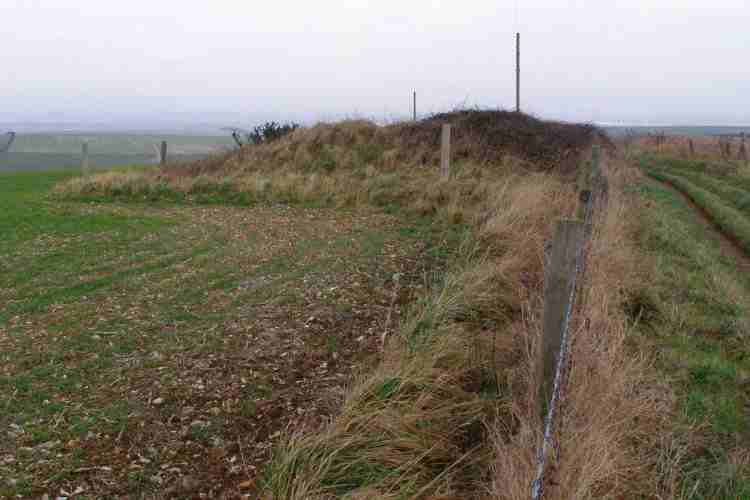
9 - Hopton-on-Sea, Norfolk - is a village, civil parish and seaside resort on the coast of eastern England in the county of Norfolk. It is located some 8 km south of the town of Great Yarmouth and very close to the UK's most easterly point, Lowestoft Ness.[1]
The Michael Alignment
- Bury St Edmunds Abbey Grid Ref: TL
85905 64254
The remains of the once great Abbey of St Edmund at Bury ruined following the
Dissolution of the Monasteries in 1539, was once one of the richest Abbeys in
England. Originally founded circa 633 by the first East Anglian martyr-king,
Sigeberht, it later became the burial-place and shrine of the last East Anglian
martyr-king, Edmund, one of the patron saints of England. The Abbey
incorporated two churches St Margaret's and St James. This site is the last
principal place on the alignment, which may or may not have extended further
towards the coast.
The projected line passes into the North Sea at the southern end of Hopton on Sea.
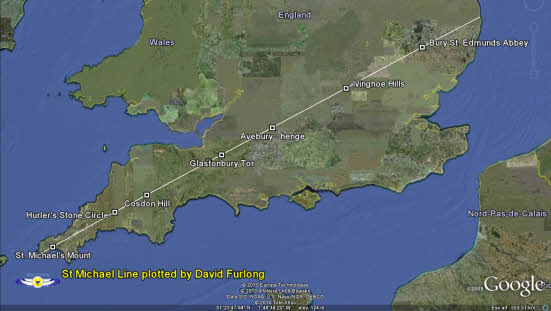
17 - Thursford. Norfolk - The village is 16.3 miles south-west of Cromer, 24.5 miles north-west of Norwich The village lies 6.9 miles north-west of the nearby town of Fakenham.
40 - Duel Stone, Norfolk - The Dual Stone at Norwich Road -
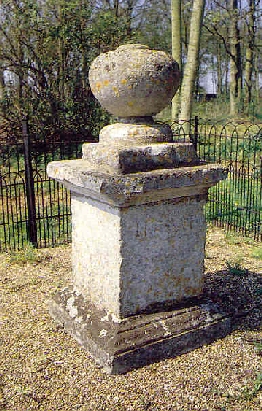
19 - Lundy Island - ( Early Ireland - Templar connection )
The Mystery of Stone Circles - Paul Mason
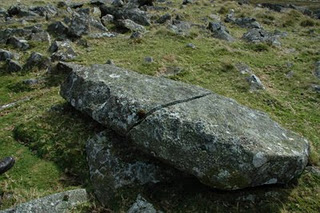 Preseli bluestone - abandoned because it cracked?
Preseli bluestone - abandoned because it cracked?
Anyone familiar with the Preseli mountains will be aware that there is ample loose bluestone over a number of peaks in the mountain range and would therefore not need to be quarried but pieces the appropriate size simply collected with minimal effort for use in the monument requiring later minimal dressing prior to erection. The bluestone constructions at Stonehenge were built and rebuilt maybe as many as five times over a 400 year period. We do not know if all the bluestones were brought at the same time, but it is quite conceivable that different working parties, possibly generations apart, collected from different sites in the Preseli mountains. As Rob Ixer told BA, had “different groups [of people] brought different stones?”
Stonehenge - The Bluestones; from Stonehenge and the Old Gods by Mystic Realms
Until the advent of the railways transport by water was the only way to effectively move large heavy objects over long distances.
Thus it is likely that much of the transportation of the bluestones from the Preseli Mtns. to Stonehenge was by
water. First by river, then along/across the Bristol Channel/Severn Estuary, then lastly by river to Stonehenge; and while we can't be certain which rivers were used
we can be certain that in their passage across the Bristol Channel/Severn Estuary the bluestones would have been carried past Lundy Island.
Lundy Island, from Lundy, Isle of Avalon by Mystic Realms
Giant's Graves on Lundy island
During harvest time in 1851 islanders on Lundy discovered two immense granite coffins, one of them said to have been ten feet long the other eight. When these sarcophagi were opened,
the excavators found the skeletons of two eight feet tall humans, seven other skeletons of normal stature and other assorted human bones. Either in the coffins themselves or beside them, sources vary, were found some pale blue stone beads and some fragments of pottery.
The date attributed to the beads, and also the graves, is anywhere from Roman times to the 14th century. The beads were apparently sent to Bristol Museum but
there seems to be no record of what happened to the human remains.
Geoffrey de Marisco, Justiciar of Ireland b. Abt 1170 d. Abt 1245
The nephew of the Archbishop of Dublin, and related to King Henry II,
Geoffrey de Marisco was Justiciar (chief governor) of Ireland for eight years
between 1215 and 1228.
...
On 1 July 1231, "Richard Marshall presented himself to the king as the heir
of his brother William Marshall [who had died in early April] ...The king in
reply, by the advice of the justiciary Hubert [de Burgh], told him he had heard
that his deceased brother's wife was pregnant, on which account he could not
listen to his demand till the truth of this matter was discovered." Richard
Marshall was then exiled, accused of associating with the king's enemies in
France.
In 1234, advisers of the king misled him (in their own best interests) into
ordering Geoffrey de Marisco "to seize him [Richard Marshall] if he should
happen to come to Ireland, and bring him, dead or alive, before the king".
Richard Marshall's extensive Irish holdings were promised as a reward to whoever
carried out this task.
On 1 April 1234, Richard Marshall and a handful of men loyal to him, along with
his supposed friend and ally Geoffrey de Marisco and his own soldiers, were
surrounded and outnumbered ten to one by the infamous Hugh de Lacy and a large
number of knights on the Curragh. Marshall was called on to surrender. Geoffrey
advised him against it, and Marshall refused to surrender.
When the fighting started, Geoffrey withdrew with his men, announcing to
Marshall, "My wife is the sister of the noble Hugh de Lacy [some historians
doubt this], and I cannot fight on your side against him with whom I am allied
by marriage."
Marshall said he would "seem a man of a wavering mind" if he
surrendered then, and the battle went on. Marshall killed six of the knights,
and the others feared to approach him. They persuaded foot soldiers to maim his
horse with lances, pitchforks, axes and halberds. As he lay helpless on the
ground in his amour, one of his enemies lifted up his amour and wounded him in
the back. He had fought for ten hours.
Richard Marshall was taken to a supposed friend's castle for medical
treatment. He recovered enough to walk about and play at dice, but after further
"treatment" by a doctor who probed his wounds with a red-hot poker, he
died 16 April.
Afterwards, Richard Marshall was proclaimed "The Knight of the Curragh"
for his heroic stand. Roger of Wendover says of him, "Amongst the sons of
men his person was so beautiful that nature seemed to have striven with the
virtues in its composition."
Geoffrey and his son William were at the same time accused of involvement in the
assassination and fined for siding with the murdered knight against the king.
Both charges seem to have been more or less justified. Afterwards, William began
a vendetta that "disturbed the peace and affected the peace of mind of the
king himself for many years", until eventually he avenged Marshall by
killing the chief assassin.
The de Mariscos were outlawed and became pirates on the Irish Sea [Lundy
Island]. They concentrated their depredations on shipping to Dublin and
Drogheda, which prompted Dublin to beef up its city walls.
This is related to: Medieval English genealogy William Marshal ( Earl de Pembroke)
14 May 1219 William Marshal died at Caversham near Reading. As he lay dying he fulfilled his vow to the Templars by becoming one of their order and by his own directions was buried in the Temple Church at London.
William left behind a widow, five sons and five daughters. Ironically,
none of his sons left sons and the great Marshal barony lasted only a single
generation.
...
Postscript: years later, about 1240 or so, the body was moved and the tomb
opened. The body was putrid with decay. Matthew Paris, a monk and chronicler,
regarded this as evidence of Wm's sins. He had died an excommunicant (by the
Irish Bishop of Ferns).
Homage and hostages
Marshal returned to England where he and his young wife had five young
sons. To protect them he remained affable to the king, while building up his
castles in southwest England and confirming his wife’s claim to Leinster as
the daughter of the earl of Clare and the granddaughter of the king of Leinster
.
In 1205 to retain his Norman lands, Marshal did liege homage for them to
Philip, the French king. This obliged him to give Philip military service when
he was in France. It was a necessary and practical step, but it made John
angry.
King John's fury exploded while organising the campaign to recover his possessions in Normandy and Poitou in 1205. Marshal refused point-blank to go with him. John accused him of treason and told the knight-barons to make an example of him. They refused, impressed by Marshal's warning, delivered with his customary force of character, “Be on alert against the king: what he thinks to do with me, he will do to each and every one of you, or even more, if he gets the upper hand over you” (The History of William Marshal, ll. 13171–4).
John furiously ordered his household knights to challenge Marshal, who was nearly sixty, to combat. None dared. Taking heart from him, the knight-barons refused to accompany John to France, and forced the cancellation of his expedition.
Marshal had managed to hold the king at bay, but the king’s power was great. John demanded that Marshal give his eldest son, William, who was fifteen, as a hostage for his loyalty.
It was a cruel demand because William Marshal and his son “were devoted to each other” (DNB), but if he refused, the King would wage war against him and take all he possessed. His only reasonable chance of keeping his son and his family alive was to agree.
Marshal goes into exile
Forced to leave his sons William and Richard as hostages for his good behaviour, Marshal entered the political wilderness. His great ally, Hubert Walter, Archbishop of Canterbury, who had helped him to keep John in check, died in July 1205.
In 1206 Marshal decided to move to Ireland with his wife, the countess. They settled in Leinster with men loyal to them, but it was not long before John demanded that he return to England.
Expecting the worst, Marshal travelled with a small band of knights, leaving his remaining knights to hold his castles in Ireland. John demanded that all his men return, but in Ireland Marshal's men refused. They defeated the forces which the king sent to to attack them, and placed the countess in control of Leinster. John came to terms, and William Marshal and his countess settled down to life in Ireland.
[ This all connects later with :
1279 - Rochester
- Protection for David de Pembrok, and Cecilia la Utlaghe (from
Ireland) ]
So it seems the Outlawe family had early connections with Earl of Pembroke William Marshal and Isabel De Clare family
William Marshal, 1st Earl of Pembroke ...
During the old king's last days ( King Richard I ) he had promised the
Marshal the hand and estates of Isabel
de Clare (c.1172–1220), but had not completed the arrangements. King
Richard however, confirmed the offer and so in August 1189, at the age of 43,
the Marshal married the 17-year-old daughter of Richard
de Clare (Strongbow). Her father had been Earl
of Pembroke, and Marshal acquired large estates and claims in England,
Wales, Normandy
and Ireland. Some estates however were excluded from the deal. Marshal did
not obtain Pembroke and the title of earl, which his father-in-law had enjoyed,
until 1199, as it had been taken into the king's hand in 1154. However, the
marriage transformed the landless knight from a minor family into one of the
richest men in the kingdom, a sign of his power and prestige at court. They
had five sons and five daughters, and have numerous descendants (see below).
William made numerous improvements to his wife's lands, including extensive
additions to Pembroke
Castle and Chepstow
Castle.
...
The Fate of the Marshal Family
During the civil wars in Ireland, William had taken two manors that the Bishop
of Ferns claimed but could not get back. Some years after William's
death, that bishop is said to have laid a curse on the family that William's
sons would have no children, and the great Marshal estates would be scattered.
Each of William's sons did become earl of Pembroke and marshal of England, and
each died without issue. William's vast holdings were then divided among
the husbands of his five daughters.
The title of "Marshal" went to the husband of the oldest
daughter, Hugh
Bigod, 3rd Earl of Norfolk, and later passed to the Mowbray dukes
of Norfolk and then to the Howard dukes of Norfolk, becoming "Earl
Marshal" along the way.
The title of "Earl of Pembroke" passed to William
of Valence, the husband of Joan Marshal's daughter, Joan
de Munchensi; he became the first of the de
Valence line of earls of Pembroke.
Richard Marshal, 3rd Earl of Pembroke (1191–16 April 1234), married Gervase le Dinant. He died in captivity. They had no children.
Ailbe Ua Maíl Mhuaidh ... Bishop of Ferns
In 1189 - Ua Maíl Mhuaidh was shortly afterwards made bishop of Ferns, the see having been previously declined by Gerald of Wales. He was present at the coronation of Richard I on 3 September 1189. On 5 November, he was appointed by Pope Innocent III, with the Archbishop of Tuam and Bishop of Kilmacduagh, to excommunicate the Bishop of Waterford, who had robbed the Bishop of Lismore. In 1205, Ua Maíl Mhuaidh received 10 shillings from the royal gift, and on 3 April 1206 was recommended by the king to the chapter of Cashel for archbishop.[1]
In November 1207, Innocent addressed a letter to Ua Maíl Mhuaidh with reference to persons who had been improperly ordained. On 17 June 1208, Ua Maíl Mhuaidh was sent by the king on a mission to the King of Connaught. On 15 September 1215, he had protection while attending the council at Rome; and on 5 September 1216 received custody of the bishopric of Killaloe.[2]
Excommunication of Earl of Pembroke
William Marshal, 1st Earl of Pembroke, while in Ireland between 1207 and 1213, seized two manors belonging to the Bishop of Ferns. For this Ua Maíl Mhuaidh excommunicated him; but the earl pleaded that it was done in time of war, and retained the manors all his life.
After Marshal's death, Ua Maíl Mhuaidh came to the king at London and petitioned for the restoration of his lands. King Henry I begged the bishop to absolve the dead, but Ua Maíl Mhuaidh refused to do so unless restoration were made. To this the younger William Marshal and his brothers refused their consent, and Ua Maíl Mhuaidh then cursed them, and foretold the end of their race.[3]
The quarrel appears to have been at a crisis in 1218. On 18 April of that year, Ua Maíl Mhuaidh was prohibited from prosecuting his plea against William, earl Marshal, and on 25 June Pope Honorius III directed the Archbishop of Dublin and the legate to effect a reconciliation between the bishop and the earl.[4]
Lundy
Island, from Lundy, Isle of Avalon by Mystic Realms
Giant's Graves on Lundy island
During harvest time in 1851 islanders on Lundy discovered two immense granite
coffins, one of them said to have been ten feet long the other eight.
When these sarcophagi were opened, the excavators found the skeletons of two
eight feet tall humans, seven other skeletons of normal stature and other
assorted human bones. Either in the coffins themselves or beside them,
sources vary, were found some pale blue stone beads and some fragments of
pottery. The date attributed to the beads, and also the graves, is anywhere
from Roman times to the 14th century. The beads were apparently sent to
Bristol Museum but there seems to be no record of what happened to the human
remains.
| - - - - - -
THE
COASTS OF DEVON AND LUNDY ISLAND THEIR TOWNS, VILLAGES, SCENERY,
ANTIQUITIES AND LEGENDS
JOHN LLOYD WARDEN PAGE
AUTHOR OF 'AN EXPLORATION OF DARTMOOR AND ITS ANTIQUITIES, AN EXPLORATION
OF EXMOOR AND THE HILL COUNTRY OF WEST SOMERSET,' 'THE RIVERS OF DEVON, FROM
SOURCE TO SEA,' 'OKEHAMPTON: ITS CASTLE,' ETC., ETC.
WITH MAP AND ILLUSTRATIONS
LONDON - HORACE COX - WINDSOR HOUSE, BREAM'S BUILDINGS, B.C.
1895
...
PART II. LUNDY ISLAND.
CHAPTER XIII. A GENERAL DESCRIPTION.
...
CHAPTER XIV. THE ISLAND KINGDOM.
...
Hubba Skeleton
A large area at the back of the farm is covered with outbuildings, not in the
best condition in fact, they look as
though they had been put up with a view to greater agricultural developments
than have as yet made their appear-
ance and then neglected.
They are all, as is the Manor House itself, of modern date some, indeed,
erected within the last few years.
It was while some of these " improvements" were in progress that
the workmen made a curious discovery.
While digging foundations for the wall of the rickyard, they came upon
a pair of kistvaens, or stone coffins, built of granite, and each covered with a
large slab.
The larger grave was loft, in length, and provided with a lump or pillow of
granite, hollowed out for the reception of
the head of a gigantic skeleton which lay within. The feet rested on another
block.
The smaller cist, which also contained a skeleton, was but 8ft. long, and
differed from the other in having no head or foot rest. Both were covered
with a pile of limpet shells.
Mr. Heaven was sent for, and the skeletons carefully measured.
The larger had a stature of 8ft. 2in.
Mr. Heaven was present the whole time, and not only saw the measurement taken,
but, as he himself told me, saw one of the men place the shin-bone of the
skeleton against his own, when it reached from his foot half-way up his thigh,
while the giant's jaw-bone covered not only his chin, but beard as well.
The skeleton in the smaller cist, although that of a very tall person, was
thought little of beside that of the giant.
Mr. Heaven, who has some knowledge of anatomy, considered it to be that of a
woman.
Close by seven other skeletons were discovered, but these were of ordinary
stature, and buried without stone coverings.
At the end of the line lay a great quantity of the bones of men, women, and
children, buried in one common grave.
Some glass and copper beads and one of gold were found with these bones, and
a few fragments of pottery. Some of these were preserved, and the bones were
then covered up.
As Mr. Chanter says, "it is most difficult to assign an era or to account
for this sepulture ; the remains of women and children precluding the idea of
its betokening the slain in battle, but rather the indiscriminate slaughter of
an entire population." Still, as he points out, this does not explain
the peculiar character and contents of the kistvaens.
These he refers to the Celtic period. But did the Celts produce such giants as
the pair interred in these stone coffins?
I fancy not.
Mr. Heaven exclaimed, when he saw the larger skeleton, " the bones of Hubba
the Dane !"
and the proportions are certainly rather Scandinavian than Celtic. Undoubtedly
it was the custom of the Danes to remove their more honoured dead, and Lundy
was "the nearest point to which the defeated army and ships could
retreat."
...
Ubbe Ragnarsson - Ubbe, Ubba or Hubba Ragnarsson was a Norse leader during the Viking Age. Ubbe Ragnarsson was one of the sons of Ragnar Lodbrok and, along with his brothers Halfdan and Ivar the Boneless, a leader of the Great Danish Army. [1]
In 878, a party of Vikings landed on the English coast at Combwich. There they observed that a number of Saxons had taken refuge in the fort of Cynwit. The Vikings proceeded to besiege the fort, expecting the English to surrender eventually from lack of water. Instead of waiting to die of thirst on top of the hill, the Saxons attacked suddenly out of the fortress at dawn, taking the Danes by surprise and winning a great victory. Ubbe was killed by the Saxons under the leadership of Odda of Devon at the Battle of Cynuit in Somerset. The town of Hubberston in Pembrokeshire, South Wales was named for him.[2] Little is known about Ubbe Ragnarsson. The information that is available about him is written principally in the Anglo-Saxon Chronicle.

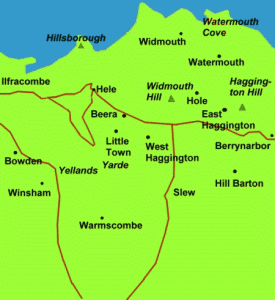 Saxon Hele Bay, Ilfracombe, north Devon
Saxon Hele Bay, Ilfracombe, north Devon
When the Saxons were well established, in the winter of 878, early in the reign of King Alfred, Hubba the Dane attacked the north coast of Devon but was slain with over 800 men, and his standard, the Raven, was captured.
It has been variously suggested that this battle was at Kenwith Castle near Bideford; Wind Hill at Countisbury; Clovelly Dykes near Clovelly; Cannington Park in Somerset and Castle Hill near Beaford. A few years later there was another attack on a north Devon fort, usually thought to be Burridge hillfort, or possibly Ilfracombe, which had a Saxon defensive tower, now part of Holy Trinity Church. King Alfred may be remembered in the name Ilfracombe, thought to mean Alfred's valley, but it more likely remembers the name of a local lord.
The Danes never occupied north Devon, but certainly occupied Lundy (a Danish word meaning Puffin Island) and some graves found there probably date from the 9th century. One of them, called the Giant’s Grave, contained the skeleton of a man of unusual stature, some 8’ 2" tall and it was speculated that he was Hubba (5).
History of Northam village Devon
There are ancient records of Northam around the 10th/11th Century and also the story of the battle with “Hubba the Dane” at Bloody Corner in the late 9th Century. The tradition says he landed at, what is now Boathyde (Hyde being the word describing a Cove, the cove being behind the embankment), with a fleet of 33 ships and marched to attack the “Hill Fort” at Kenwith. Legend states that they were defeated by Odun, Earl of Devon, he and 1000 of his men were killed, the men being buried at Bonehill (Bunhill being the old name for a burying ground), and he being buried in a Cairn, in the area now known as Hubbastone.
There is a stone Tablet at Bloody Corner, in Northam, erected by Charles Chappell, which says:-
“Stop Stranger Stop,
Near this spot lies buried
King Hubba the Dane,
who was slayed in a bloody retreat,
by King Alfred the Great”
So what really happened, and who really was involved will probably be never known.
There is also an area in “The Copse”, Northam Woods, which is called King Alfred’s
Cave, and is reputed to be where King Alfred hid when being chased by
Vikings/Danes.
Bristol - Stanton Drew Stone Circle - This stone circle is not as famous as Stonehenge or Avebury, which is why there are a lot less tourists visiting it. This makes it a very atmospheric experience however, and with a little luck, you are the only one there. Except of course for the sheep grazing in the field. A definite recommendation if you are looking for an ancient site without the busloads of tourists.
Stanton Drew stone circles - Wikipedia, the free encyclopedia
Stanton Drew - Stone Circles and Cove - Stanton Drew, Avon
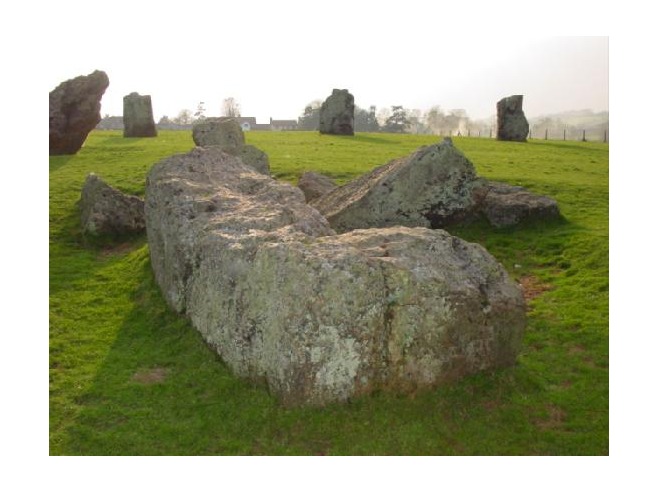
Journal of the Royal Society of Antiquaries of Ireland - THE KILKENNY ARCHAEOLOGICAL SOCIETY VOL. XLV. CONSECUTIVE SERIES VOL. V. SIXTH SERIES 1915

The use of a counter seal, which was common in the thirteenth century, was doubtless to prevent the removal of a seal from one document and its transfer to another for fraudulent purposes ; when the wax was impressed on one side only it was possible to cut away the face of the seal with a heated knife, but when the wax was impressed on both sides this process was rendered considerably more difficult.
Dr Lyon also drew a seal of a subsequent Prior of Kilmainham, that of Roger Utlaugh. The original seal was attached to a deed dated 1318 A.D., and a small portion (about a third) still remains. Dr Lyon's drawing shows that the design of the seal, which is circular, and measures 1| inches in diameter, is the same as the last, but the inscription is different ; it reads : — + SIGILL : CONVENT • DOMUS HOSPITALIS IN HIBERNIA
(Plate XIII, fig. 3). The counterseal is also circular, and measures 1 inch in diameter. The device is a shield bearing the arms of the Order of the Knights of St John of Jerusalem, silver a cross gules. The shield has a bird like a swan on each side, and is enclosed in an ornamental panel (Plate XIII, fig, 4). The inscription reads + si • pris rogeri outlawe.
^ Roger Utlaugh was one of the most distinguished of the Priors of Kilmainham : he combined his office with that of Lord Chan- cellor of Ireland, and was for a time Lord Deputy as well."^ His seal is therefore of considerable interest.
There is a description of the seal of Wilham FitzThomas, another Prior of Kilmainham in the British Museum Catalogue of Seals, vol. iv, p. 717. The seal is stated to be imperfect, the device being a shield of the arms of FitzThomas, a saltire charged with a cross paty, and a helmet surmounted by the Agnus Dei. It is dated 1430 a.d. The last seal to be described is that of the Official of Glendaloch, which was attached to a deed dated 1314 a.d. A fragment of the original seal still remains. Dr Lyon's drawing shows that it bore the effigy of St Kevin represented habited as an abbot with amice, alb, dalmatic, and chasuble, holding a crozier turned outwards in his right hand and a book in his left. It is possible that the curious, flat cap on the Saint's head is an error in the drawing, and that in the original seal it was an exaggerated tonsure. The seal is pointed- oval in shape, and measures 1| by | inches. The inscription round the edge of the seal had evidently disappeared at the time Dr Lyon made his drawing, but in the body of it can be read the Saint's name beat : keivinvs (Plate XI, fig. 5).
1279 - Rochester - Protection for David de Pembrok, and Cecilia la Utlaghe (from Ireland) ]
1285 - Oct 18 - Kilkenny. David de Pembroke, for pledge of Thos. le Mercer
ACCOUNTS OF THE EARL OF NORFOLK'S ESTATES IN IRELAND, 1279-1294.
By JAMES MILLS, M.R.I.A.
Roqer Bigod, Earl of Norfolk, Earl Marshal of England, was one of the foremost of the English nobles under Edward I. His independent opposition to the unconstitutional demands of that sovereign are
well known matters of history. He was the last earl of his race; and, on his death in 1306, his vast estates passed to the Crown. Either then, or on the occasion of a temporary seizure of his possessions during his life, there were transferred to the king's exchequer from the earl's repositories a collection of several hundred little rolls of accounts of the receivers and bailiffs of his numerous lordships and manors, extending from about the seventh to the twenty-second year of King Edward's reign. Happily these rolls have escaped the ravages of time and the utilitarian clearings out by old officials, and are still preserved in the London Record Office almost in as good condition as when, 600 years ago, their various items were carefully examined and cautiously passed by the earl's treasurers.
The earl had inherited through his grandmother, the eldest daughter of William, Earl Marshal, beside many manors in England, the lordship of Catherlagh or Carlow, being a fifth part of the great lordship of Leinster which had been acquired by Strongbow.
Nearly 100 of these rolls relate to this Irish estate. Of these, so far as I am aware, no use has yet been made by Irish students. Mr. Sweetman overlooked them when preparing his " Calendar of Documents relating to Ireland," though they have been briefly referred to by Professor Thorold Rogers in his "Work and Wages."
...
The Earl of Norfolk, with his vast English estates, placed, by his office of Hereditary Earl Marshal, at the head of the English baronage, was necessarily an absentee from his Irish property.
His visits were few and short. But in the thorough organization of their government the estates seem to have suffered little from his absence. Indeed, one of the few references to his visits deals only with the lawlessness of his followers. In 1281 the provost of the manor of Fothered had to expend fourpence in the purchase of four keys for the doors of the hall, the chamber, the pantry, and the buttery, to replace those lost by the earl's men.
...
Account of the Treasurer of Carlow, 1283
Account of Thomas Wade, Treasurer of Catherlagh - 10th year of King Edward
The Earl of Norfolk's Estates in Ireland 61
Robes for Christmas
In 61 ells of burnet bought for the use of the seneschal and other knights, the treasurer, and Ely as de Ybestan £12 Is. In 1J pieces of cloth of burell bought for the use of William de Weston (John son of William,
David de Pembrok, struck out because no writ) Henry Talun sheriff, Ralph Wade constable of Catherlagh, Thomas de Clone constable of Fothcred, and Ralph de Lunt constable of Old Ros, £7 10s. In 6 furs of stradlingi for the use of the knights, 60s. Also in 6 furs of scurell for use of the same 33*. Also in 6 furs for the hoods of the knights bought, of minever, 27s.; price of each 4s. 6d. In 5 furs bought for use of the valetti 8s. 6d. Given to Robert the Clerk for his robe and fur 22s. 9d. Sum £27 2s. 3d.
Walter de Bodenham seems to have been "Lord of Byford" so there are more connections -> de Baskerville and de Montfort Hereford:
Collections towards the history and
antiquities of the county of Hereford ... By- John Duncumb, William Cooke, Morgan George Watkins, John Hobson Matthews
...
In the twelfth century, Ralph de Baskerville held a moiety of Buiford, having
Roger de Bodenham his sub-lessee, whose descendant having joined the army of
Simon de Montfort, was deprived of his lands in Bodenham -and Byford, but
recovered the latter on payment of the penalty imposed by the dictum of
Kenilworth.
Walter de Bodenham had an elder son, Robert, who was certified in 1316 to be lord of a vill in Buiford ; another Walter de Bodenham left his moiety of Buiford in 1371 between two sons, John and Thomas, and at the death of the survivor in 1433, this property, held by knight service of the honor of Weobley, passed to a kinsman, Roger Bodenham, who, on the avoidance of the rectory in 1437, with others describing themselves as " feoffees of the Lordship of Byford," claimed the right of presenting to the benefice.
Calendar of Documents Relating to Ireland:1285-1292 By Great Britain. Public Record Office
1285 - Oct 18 -
Kilkenny. David de Pembroke, for pledge of Thos.
le Mercer
The same, for licence to have a better writ
Walter de Pembroke, fine for himself and pledges for not prosecuting
Isabella de Pembroke, for licence to have a better writ, by Adam de Pembroke
David de Pembroke, for the same
[ This starts to intertwine with the Kyteler witch
trial: ]
The
history, architecture, and antiquities of the cathedral church of St. Canice
KilKenny - James Graves
Between the years 1277 and 1279 John de Valle filled the
important office of seneschal of the Liberty, and made a figure in a
law-suit connected with his jurisdiction there, which was, doubtless, looked
upon with much interest at the time, as he was accused of infringing the
clerical privileges. It appears that he caused David de
Pembroke, clerk, to be arrested and imprisoned in the castle of Kilkenny,
during a day and night, for rescuing a horse, his property, which had
been seized, under an order from the seneschal's court, for debt
...
In 1309 we find a Richard de Valle holding property in Kilkenny
and Carrick, and married to the famous Kilkenny witch,
Dame Alice Kyteler, being her third husband
Proceedings and transactions of the Kilkenny and South-east of Ireland Archaeological Society
The Rev. James Graves contributed a transcript of an
ancient charter, the original of which was preserved in the Evidence Chamber, Kilkenny
Castle. In addition to some other interesting peculiarities, it was
connected with the name of Clyn, at a period when the annalist Clyn was alive,
and, it might be fairly presumed, with a member of the same family. The
researches of Dean Butler, the writer of the admirable introduction to Clyn'g
and Dowling's Annals, as published by the Irish Archaeological Society, have not
brought to light much connected with this eminent historian. That he was a
native of Kilkenny has been presumed from the
importance given to Kilkenny matters in his
annals; but, except that a person of a somewhat similar name was parson of the
Church of the Holy Cross of Castlecomer in the fifteenth century,1
nothing further had hitherto been ascertained. This charter, however, proved
that Nicholas de Clyn was the husband of Margaret de
Pembroke, and had certain rights of property in the county of Kilkenny
in 1331.
...
Rogerus de Pembrok miles. It appears by the Patent Roll of the 11th year of Edward II., that Roger, son of Roger de Pembrok, was, in consideration of services done, forgiven by the King £115, due by the former as sheriff of Tipperary; and by the Patent Roll of the 18th year of the same King, that Roger de Pembrok, Knight, was bound, along with other persons connected with Kilkenny, in the sum of £1000, to Richard de Ledrede, Bishop of Ossory.
The latter entry connects Sir Roger de Pembroke with the celebrated prosecution for witchcraft got up by the Bishop against Dame Alice Kyteler. The connexion of the Clyns, by marriage, with the knightly family of De Pembrok is an interesting fact. The name Pembroke still exists in Kilkenny, but, like the names of others of the proudest of the early Anglo-Norman settlers, it has descended to the humbler ranks of society. Attached to the deed is an impression, in brown wax, of Sir Roger de Pembrok's seal: it is circular, about 1J inches in diameter, and bears on a heater-shaped shield, a chevron between three crescents. The shield seems also to be divided per pale. Burke in his " General Armory" gives —Pembrooke, per pale argent and or a chevron between three crescents gules. Round the edge of the seal runs the legend, in Lombardic capitals,
1335 - William
Outlawe. - Names of
Persons summoned to attend John Darcy, Justiciary, with arms and horses in his Expedition
to Scotland
1335 - Persons
summoned by John Darcy, Justice Ireland, with arms and horses in his Expedition
to Scotland in 1335 - Roger de Pembrok
The journal of the Royal Historical ... - Royal Historical and Archaeological Association of Ireland
It is matter of history that a large Irish force attended Edw. III. into Scotland at this period.
Writs of summons were sent to the Earls of Ormonde and Desmond, to 55 knights, 11 Irish princes or chiefs, and 111 esquires, commanding them to attend with horsed and arms the Lord Justice Darcy into Scotland against the king's enemies and rebels. The annalist Clynn tells us that, attended by these Earls and other Irish magnates,
the Lord Justice Darcy embarked in 56 ships after the Assumption of the Virgin (Aug. 15)
1335, and having entered Scotland, and spoiled, burned, and conquered the
Islands of Arran and Bute, returned home all safe
- Isle of Bute
This is sort of interesting since Darcy is connected to the De Burgh's by
marriage and that connects with beginning Burgh Castle Norfolk:
John Darcy, 1st Baron Darcy de Knayth (c. 1290 – 30 May 1347), was an English peer. He was born circa 1280, probably at Knaith, Lincolnshire, the son of Roger de Darcy and Isabel D’Aton.
He became one of the most trusted advisors to King Edward III and was appointed High Sheriff of Nottinghamshire, Derbyshire and the Royal Forests in 1319, High Sheriff of Lancashire in 1323 and High Sheriff of Yorkshire in 1327. He served as Member of Parliament for Nottinghamshire in 1320.
He was steward to the king (1337–1340) and then chamberlain (1342–1346). In 1339 he was appointed Lord Justice of Ireland and was summoned to Parliament in 1331, 1333 and 1341 as "Johanni Darcy le Cosin". In 1342 he joined the Earl of Northampton on an expedition to Flanders and on his return was made Constable of Nottingham Castle (1343–1344) and of the Tower of London (1345–1346). He took part in a number of wars against the Scots and French and fought at the Battle of Crecy in 1346, being sent home by the king to announce the victory in Parliament. He was created the first Lord Darcy of Knayth.[1]
He died in 1347 and he was buried at Gisborough Priory. He had married twice: firstly Emmeline, the daughter of Sir Walter of Silkstone, with whom he had one son, John, and secondly Joan, widow of Thomas FitzJohn, Earl of Kildare, and daughter of Richard de Burgh, Earl of Ulster. He was succeeded in the barony by his son John
Richard Óg de Burgh, 2nd Earl of Ulster - and 3rd Baron of Connaught (1259 – 29 July 1326), called The Red Earl, was one of the most powerful Irish nobles of the late 13th and early 14th centuries.
A son of Walter de Burgh, the 1st Earl of Ulster (of the second creation) and Lord of Connacht.[1] His name, "Richard Óg", meant Richard the Young, probably a reference to his youth when he became earl in 1271, or to differentiate him from his grandfather, Richard Mór.
Earl of Ulster
Richard Óg was the most powerful of the de Burgh Earls of Ulster, succeeding his father in Ulster and Connacht upon reaching his majority in 1280.[1] He was a friend of King Edward I of England, and ranked first among the Earls of Ireland. Richard married Margaret, probably a daughter of Count Arnold III of Guines and a descendant of Edward I.[2]. He pursued expansionist policies that often left him at odds with fellow Norman lords.
His daughter Elizabeth was to become the second wife of King Robert the Bruce of Scotland. However, this did not stop him leading his forces from Ireland to support England's King Edward I in his Scottish campaigns and when the forces of Edward Bruce invaded Ulster in 1315, the Earl led a force against him, but was beaten at Connor in Antrim. The invasion of Bruce and the uprising of Felim Ó Conchúir in Connacht left him virtually without authority in his lands, but Ó Conchúir was killed in 1316 at the Second Battle of Athenry, and he was able to recover Ulster after the defeat of Bruce at Faughart.[1]
He died on 29 July 1326 at Athassel Priory, near Cashel, County Tipperary.
Children and family
The original Irish "de Burgh":
William de Burgh - founder of the de Burgh/Burke/Bourke family of Ireland, d. 1206.
He arrived in Ireland in 1185 and was closely associated with Prince John.
King Henry II of England appointed him Governor of Limerick and granted him vast estates in Leinster and Munster. De Burgh's castles at Tibberaghny (co Kilkenny) Kilsheelan, Ardpatrick and Kilfeacle were used to protect King John's northern borders of Waterford and Lismore and his castles at Carrigogunnell and Castelconnell were used to protect Limerick. He was Seneschal of Munster (Royal Governor) from 1201 to 1203
... the mother of Richard Mor de Burgh, William's son and successor, was the "daughter of the Saxon [English] king", an illegitimate daughter of Henry II of England or perhaps Richard I of England. Such a connection would explain the use of the term consanguineus kinsman by Edward I of England to describe Richard Óg de Burgh, 2nd Earl of Ulster.
William had three known children (with the spelling Connaught being used in titles of English nobility):
These Normans likely derived their name from Walter de Burgh of Burgh
Castle in East Anglia; there is also a legend that they descend from Robert de
Burgo, half brother of William the Conqueror. In any case there are early
continental forms of the name, - burg is fort in Old German - Walter is also a
Germanic name.
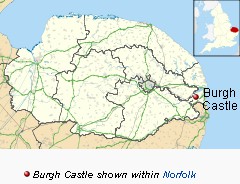
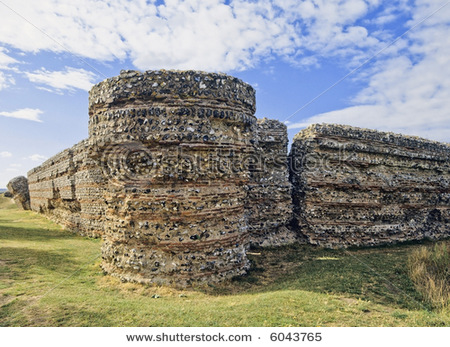
Burgh Castle - is a village and civil parish in the English county of Norfolk. It is situated on the east bank of the River Waveney, near Great Yarmouth, some 6 km west of Great Yarmouth and within the Broads National Park
Burgh Castle is the site of one of several Roman forts constructed to hold cavalry as a defence against Saxon raids up the rivers of the east and south coasts of southern Britain (the Saxon Shore).
Of course this all relates back to this:
1207 - Hubert de Burgh purchased of Roger de Burnham and Julian, his wife, William de Noiers, Robert Fitz Ralph, and Alice his wife, and Robert de Utlagh, their several nine parts of two knights fees in Runton and Beeston and Hinderingham, for which they paid castle gaurd to Dover. 9th of King John * The Norfolk antiquarian miscellany - West Runton - Beeston Regis - Hindringham - "Hindringham Outlagh Manor"
Just to review:
Hubert de Burgh, 1st Earl of Kent - (c. 1160 – before 5 May 1243) was Earl of Kent, Justiciar of England and Ireland, and one of the most influential men in England during the reigns of John and Henry III.
De Burgh was the son of Walter de Burgh of Burgh Castle, Norfolk. He was the younger brother of William de Burgh (d. 1206) who accompanied Prince John, to Ireland in 1185, and eventually became Lord of Connacht.
De Burgh remained loyal to the king during the barons' rebellions at the end of John's reign. The Magna Carta mentions him as one of those who advised the king to sign the charter, and he was one of the twenty-five sureties of its execution. John named him Chief Justiciar in June 1215.[2] and appointed him High Sheriff of Kent (1216–1222), High Sheriff of Surrey and Governor of Canterbury Castle. Soon afterwards he was appointed High Sheriff of Herefordshire and Governor of the castles of Hereford, Norwich and Oxford.
De Burgh played a prominent role in the defence of England from the invasion of Louis of France, the son of Philippe II who later became Louis VIII. Louis' first objective was to take Dover Castle, which was in de Burgh's charge. The castle withstood a lengthy siege in the summer and autumn of 1216, and Louis withdrew. The next summer Louis could not continue without reinforcements from France. De Burgh gathered a small fleet which defeated a larger French force at the Battle of Dover and Battle of Sandwich, and ultimately led to the complete withdrawal of the French from England.
He was appointed High Sheriff of Norfolk and Suffolk (1216–1225) and High Sheriff of Kent (1223–1226).
After the death of William Marshal in 1219, de Burgh effectively became regent of England. In this position de Burgh acquired a number of enemies and rivals. ... He died in 1243 in Banstead, Surrey, England and was buried at the church of the Black Friars in Holborn.
Lost London – Blackfriars Priory « Exploring London
The London area of Blackfriars – centred on Blackfriars Railway Station – takes its name from the former Dominican friary (known as the “black friars” thanks to their dark robes) which stood on the site. -
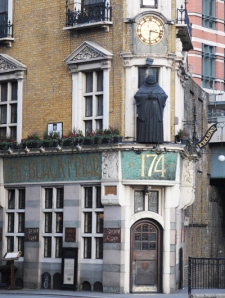 The
Dominicans first came to England in the 1220s and soon took up residence in
Holborn. But the limitations of that site led them to move to a new
location between Ludgate and the River Thames in the latter part of the 13th
century. There, they constructed a substantial priory
The
Dominicans first came to England in the 1220s and soon took up residence in
Holborn. But the limitations of that site led them to move to a new
location between Ludgate and the River Thames in the latter part of the 13th
century. There, they constructed a substantial priory
It was also a place of burial for the wealthy and influential – among those buried there was the beloved wife of Edward I, Eleanor of Castille (at least her heart was – her body was buried at Westminster Abbey).
Interesting he also has a Bristol / Wales connection with the De Burgh's Welsh Castles North of Bristol:
Hubert de Burgh had a checkered career serving the Norman monarchy in Wales. Perhaps his greatest achievement (aside from the castles) was his success against French forces led by King Philip Augustus.
After de Burgh's triumph, King Henry II granted de Burgh full rights to Skenfrith, White and Grosmont Castles. From 1219 to 1232 the Norman lord remodelled the earth and timber castle at Skenfrith into the enchanting site that survives today. Not surprisingly, de Burgh patterned his new castle at Skenfrith after ones he had encountered in France, which were dominated by round towers. Skenfrith's round keep is Hubert's great gift to us.
While the exterior of Skenfrith Castle seems fairly plain, the interior is an unexpected visual treat. Skenfrith's charm is its round keep, which immediately grasps your attention as you cross the footbridge and through the main gateway. Placed to tower above the curtain towers, the well-preserved keep not only housed the lord and his family, but also symbolized the power of the de Burgh's.
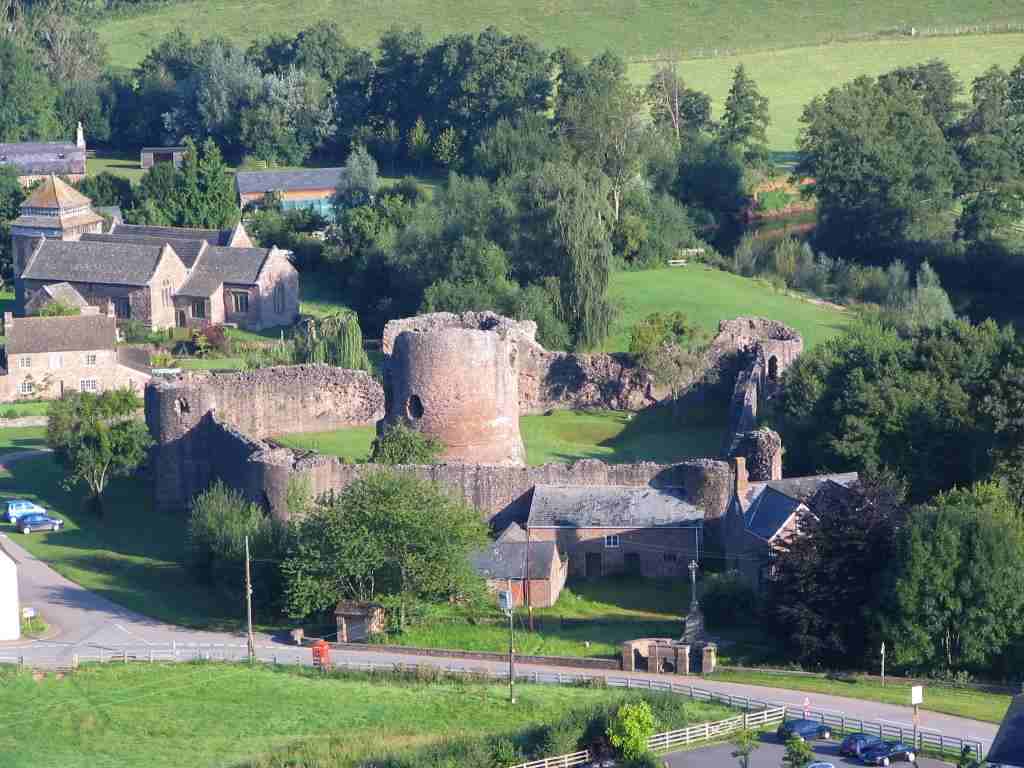
11m NE of Abergavenny, Monmouthshire, southeast Wales
White Castle - Together with Grosmont and Skenfrith, these so-called "Three Castles" formed an important strategic triangle controlling this area of the southern March. All three were royal castles in the later 12th century, and in 1201 were granted to Hubert de Burgh by King John. Unlike the other two, however, White Castle was not rebuilt by de Burgh in the new defensive style of the early 13th century.
Orford Castle - One of the first constables of Orford , Bartholomew de Glanville, was a local man who took up his post in 1167. By this time foodstuffs and supplies were being ordered, so the castle must have been habitable by then.
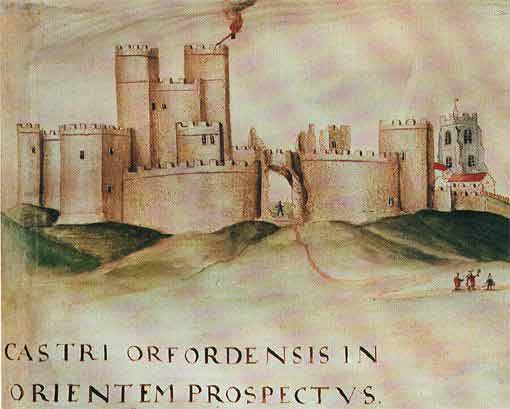
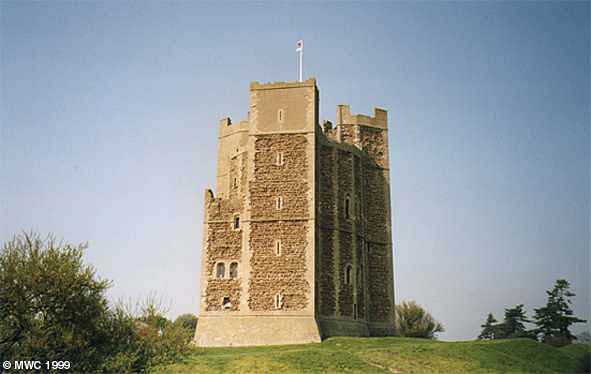
A curious incident occured in the early life of the castle. The story, as told by Ralph of Coggeshall in about 1207, tells of an incident that occurred 40 years earlier.
The story of the Orford Merman is as follows;
' Men fishing in the sea caught in their nets a wild man. He was naked and was like a man in all his members,
covered with hair and with a long shaggy beard. He eagerly ate whatever was brought to him, but if it was raw he pressed it between his hands until all the juice was expelled.
He would not talk, even when tortured and hung up by his feet. Brought into church, he showed no signs of reverence or belief. He saught his bed at sunset and always remained there until sunrise.
He was allowed to go into the sea, strongly guarded with three lines of nets, but he dived under the nets and came up again and again. Eventually he came back of his own free will. But later on he escaped and was never seen again. '
| - - - - -
Records
of the Anglo-Norman house of Glanville from A.D. 1050 to 1880 ... By William
Urmston Searle Glanville Richards
At
Orford, twenty miles from Ipswich,
there was a royal castle in the time of Henry III., who granted a
charter to the town, which was previously a borough by prescription; it is now a
mere village. Only the keep of the castle remains; it is a polygon of
eighteen sides, with walls ninety feet high, and has square towers in its
circuit, which overtop the rest of the building; the architecture is Norman,
and it was erected by Glanville; [fn 14] and
in the year 1167, when he was residing there, the fishermen took in their
nets a wild man, having the human shape complete, with hair on his head and a
long and sharp beard and a large amount of shaggy hair on his breasts. The
fishermen were not able to keep him long, as he stole away to sea privately, and
was never seen afterwards. [fn 15]
1336 - Grant, for life, to William son of Nicholas Utlawe that his houses in cities, boroughs and other places in Ireland shall be quit of livery of the king's justices and ministers there, that none of these shall make any livery or lodge in them against his will. Also that nothing shall be taken by them of the victuals and goods of him or his men in that land for the king's use against his will or without due satisfaction. By K. - July 10 Perth
Added Page "The Outlaw" B-17 at Lavenham, Suffolk, UK -
How very appropriate to have "The Outlaw" there in Suffolk. I don't know how
they got Outlaw for the name of the plane.
It maybe that it refers to "The Outlaw" movie that came
out in 1943 with Jane Russell
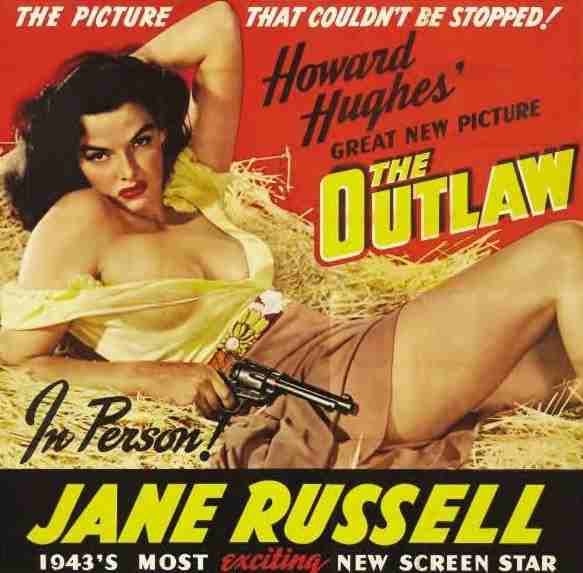
Effingham, Surrey - By 1545, King Henry VIII was hunting on what is now Effingham Golf Course whilst staying at Hampton Court nearby. The manor house and lands were then owned by Lord William Howard (the Lord High Admiral, and later 1st Baron Howard of Effingham) and it was his son the 2nd Baron Howard of Effingham (later 1st Earl of Nottingham) who commanded the English fleet against the Spanish Armada.[2]
1572 - Thomas Howard, 4th Duke of Norfolk was executed for treason in 1572
1585 - Charles Howard, 1st Earl of Nottingham known as Howard of Effingham - Howard was named Lord High Admiral in 1585
So who was this prominent Henry Outlawe Gentleman in London who was involved with the Blackfriars Playhouse in the early 1600's??? Did he know Shakespeare?
1603/4-1609 - Henry Outlawe deposes on Edward Kirkham's behalf that for a total of fifteen weeks between 1603 and 1604, Henry Evans collected 30s a week 'for the use of stools standing upon the stage at Blackfriars.' Outlawe does not believe that Evans gave account of this income to the rest of the sharers. - Blackfriars - St Anne's - London - English professional theatre, 1530-1660
Amazing it seems Henry Outlawe is a
"gentleman" working with Thespians - just after QEI's death and the
beginning of James I.... :
It would seem he had to know Shakespeare... He testifies in 1609 about events in
1603 and 1604. Why was it that HE needed to testify?
Blackfriars Playhouse
... Shakespeare and the Blackfriars Theatre - The Elizabethan Playhouse
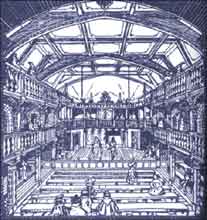 In 1600, Richard Burbage leased the Blackfriars to Henry Evans for 21 years for £40 per annum, but in August 1608, Richard Burbage took back the lease from Evans, and William Shakespeare and other King's men players became part owners of what was to become the Blackfriars Playhouse.
In 1600, Richard Burbage leased the Blackfriars to Henry Evans for 21 years for £40 per annum, but in August 1608, Richard Burbage took back the lease from Evans, and William Shakespeare and other King's men players became part owners of what was to become the Blackfriars Playhouse.
William Shakespeare bought a house a short walk away from Blackfriars theatre in Ireland Yard. The acting troupe performed at Blackfriars during the winter months while continuing to spend the summers at the Globe.
In 1619 the local residents again tried to close the theatre but due failed due to the intervention of the Privy Council.
...
The Blackfriars Playhouse Indoor Elizabethan Playhouse Theatre
The known facts about the Blackfriars Playhouse indoor Playhouse, which was used as one of the venues for English Elizabethan Theatre, are as follows:
London Location of the Blackfriars Playhouse indoor Playhouse - Ludgate Hill
The Blackfriars Playhouse indoor Playhouse was opened in - 1576
The famous people associated with the Blackfriars Playhouse indoor Playhouse were Richard Farrant, William Shakespeare and the Burbage family
...
Blackfriars Playhouse - originally a Dominican Monastery
The Blackfriars Playhouse Theatre was located in the City of London on the site of a dissolved 13th-century Dominican monastery.
The original Dominican monastery was built in 1275 and was located between the River Thames and Ludgate Hill.
...
The First Blackfriars Theatre
In 1538 the Dominican monastery of Blackfriars was closed due to the dissolution of the monasteries by King Henry
VIII. The monastery estates, which consisted of many different buildings on a vast area of land, were divided up and sold or leased.
In 1576, during the reign of Queen Elizabeth I, some of the buildings were leased to Richard Farrant who was Master of the boy choristers called the Children of the Chapel Royal. During the Elizabethan era the young boy members of the choirs were also encouraged to participate in drama. These troupes were called Children's companies. These children doubled as child actors and the buildings were used for play rehearsals and private performances prior to the 'Chapel Children' acting troupe performing at court. This was, therefore, the first Blackfriars theatre. The whole district retained the name and when the old refectory was turned into the theatre, the name was used to define its location. Plays were staged there until 1584 when the first 'Blackfriars Theatre' was closed due to various objections from City officials.
Also :
Hubert de Burgh, 1st Earl of Kent - (c. 1160 – before 5 May 1243) was Earl of Kent, Justiciar of England and Ireland, and one of the most influential men in England during the reigns of John and Henry III. ...After the death of William Marshal in 1219, Hubert de Burgh effectively became regent of England. In this position de Burgh acquired a number of enemies and rivals. ... He died in 1243 in Banstead, Surrey, England and was buried at the church of the Black Friars in Holborn.
English professional theatre, 1530-1660 - Glynne William Gladstone Wickham, Herbert Berry
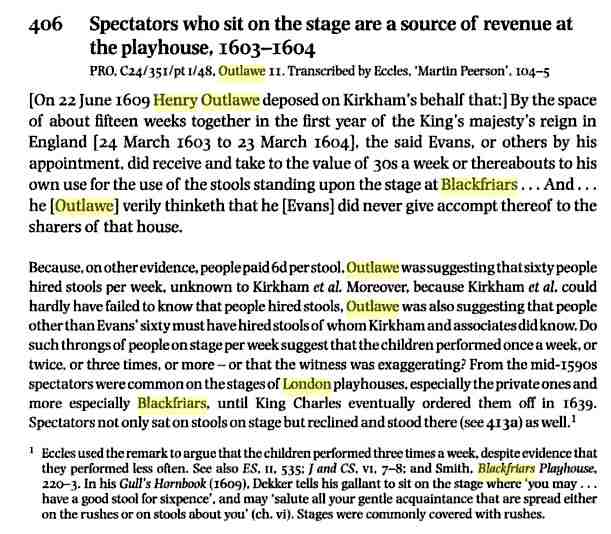
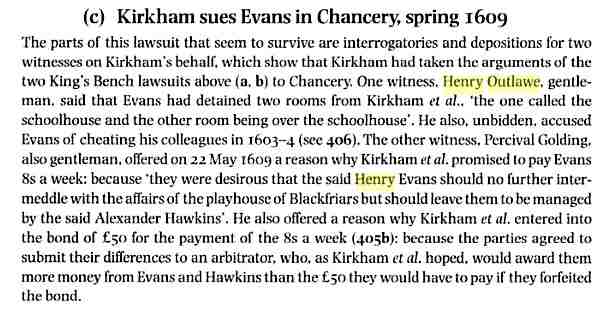
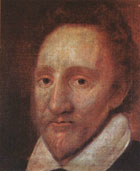 Luminarium Encyclopedia.
The Blackfriars Theatre.
Luminarium Encyclopedia.
The Blackfriars Theatre.
...
In 1596, another part of the old Blackfriars was bought by James Burbage,
owner of the Theatre and father of famed actor Richard Burbage, for £600
from the estate of Cawarden, late Master of Revels. This set of rooms, cellars,
and yards was near the Pipe office, next to the house of Sir George Cary. Burbage
spent an enormous sum to convert these rooms into a private indoor playhouse.
The residents of Blackfriars got an injunction against the theatre being used by
an adult troupe and Burbage had to lease the playhouse to children's
companies—around 1597, the Chapel Children are found in residence.
Richard Burbage, the principal actor with the Chamberlain's
Men, Shakespeare's company, inherited the second Blackfriars Theatre in 1597.
In 1600, he leased it to Henry Evans at an annual rate of £40, for a term of
21 years, and the children's performances continued. The Children of the Chapel
were renamed Children of Queen Anne’s Revels after the accession of James
I in 1603.
After the performance of Eastward Ho (1605), a collaboration between
Jonson, Marston, and Chapman, the Children lost their royal patronage,
because of a passage about Scots in Act III which offended King James so much
that he had the authors briefly imprisoned.
The playhouse ceased to be productive, and Burbage took back the lease from
Evans.
In 1608, Burbage, along with actors from his company, formed a company of
housekeepers, or owners, and began to use the playhouse. The King's Men, as the Chamberlain's
Men were now known, played at the Blackfriars during the winters. Later
works by Shakespeare, as well as works by Beaumont
and Fletcher, were
performed there.
In 1619, Blackfriars residents again tried to close the theatre, citing it as a
public playhouse, but the Privy Council intervened and confirmed its use. The
King's Men performed there without interruption until the closing of the
theatres with the English Civil War in 1642.
Bubonic Plague and Shakespeare
...
There were constant outbreaks of the Bubonic Plague and every time this occurred the Theatres were shut down. The closures occurred in 1593 , 1603 and 1608
In 1563, in London alone, over 20,000 people died of the disease - In 1665 the Great Plague of London again decimated the population of the town which killed 16% of the inhabitants (17,500 out of the population of 93,000)
The plague was not just confined to the towns. Nowhere was safe the same plague outbreak of 1563 claimed 80,000 people in England
From December 1592 until December 1593 Stow (the Elizabethan archivist) reported 10,675 plague deaths in London, a city of approximately 200,000 people.
In 1603, the plague killed 30,000 Londoners
Some other previous outbreaks of the plague in England were the 1636 plague, when some 10,000 had died, and the 1625 plague, when some 35,000 died
The Great Plague (1665–1666) was a massive outbreak of disease in the Kingdom of England (modern day United Kingdom) that killed an estimated 100,000 people, 20% of London's population
A chronicle history of the London
Stage 1559-1642 - Frederick Gard Fleay
...
From other papers also published by Mr. Greenstreet, and given in full farther on, additional particulars are ascertained, which require insertion here in a condensed form.
1597. July 15.—-N. Gyles gets his patent for the Chapel children, who no doubt acted under him at Blackfriars.
1600. Sep. 2.—-Richard Burbage let the Blackfriars building to H. Evans for 21 years from 1600, Sep. 29, Michaelmas.
1600. Dec.—Evans, Gyles, and Robinson entered on the "violent courses" mentioned in the document already given, in taking up children for their company.
1600. Dec-1601. Oct. 21.—During this interval, in the xliiith (three-and-fortieth) year of Elizabeth,
Evans was censured by the Star Chamber for his unorderly carriage in this matter, and all "assurances made to him concerning the said house or plays" were declared utterly void. The exact date was probably in April, certainly after the production of the Poetaster, and before the entry, S. R., of Cynthia's Revels, May 23. Jonson then left writing for the Chapel children, and returned to Henslow's company. Evans, finding it impracticable to carry on the Blackfriars Theatre with Gyles, &c., sought for new arrangements.
1601. Oct. 21.—Henry Evans let half the profits to Alexander Hawkins on trust for Edward Kirkham, William Rastell, and Thomas Kendall, on condition they should lay out £400, Hawkins being bound to reassign to these three men. This is Kirkham's statement; but Burbage says that the assignment to Hawkins, who, be it noted, was Evans'' son-in-law, was absolute, and that no trust deed existed to his knowledge. The three, according to Kirkham, paid Evans 8s. weekly, and Hawkins also paid Evans £$2, 10s, 0d. Why he should do this, if they took the whole benefit, does not appear.
1602. April 20.—In certain articles of agreement (according to E. Paynton's statement (we shall hear more of this gentleman in the next chapter) the above referred to lease was acknowledged to be in the absolute interest and possession of Hawkins, as it no doubt really was.
Kirkham was, as Jonson calls him in. his "Conversations," "a base fellow, and unworthy of credit."
2. The Paul's boys were not reinstated till 1600. They acted at their own singing-school. Their master was Edward Piers. See Marston's Jack Drum's Entertainment for date. It was acted in 1600, and was probably their first new play.
3. The Queen's men and the Earl of Sussex' appear, on the cessation of the Plague in December 1593, to have anticipated the other companies for a few months in recommencing. There are a few notices of them in "Henslow's Diary " as acting at the Rose until Easter 1594, which I have given above in the intercalatory section. After this
they disappear altogether from the London stage. From 1593 onwards only three men's companies were looked on as authorised in the liberties of the City, the Curtain having, in the view taken by the authorities, been replaced by the Fortune in 1600. Nevertheless, for a short time in 1599 it had been occupied by the Earl of Derby's men, who acted at Court 7th February 1600, and we hear of plays there on to 1601. In the next reign we shall find four men's companies fully recognised.
Interesting this Thomas Outlawe in 1493 seems to be the master Pewter'er in early 1500's but he also seems to know William Burbage and the Burbage family later becomes the great Shakespearian actor Richard Burbage whom Henry Outlawe may have known ....hmmm... Also there seems to be a connection to the earlier Cherteseye's and Checheley...
Abstracts of inquisitiones
post mortem relating to the city of London ... - Great Britain. Court of Chancery, London and Middlesex Archaeological Society
...
Inquisttion taken at the Guildhall, 23 March, 8 Henry VII [1493], before William Martyn, Mayor and escheator, after the death of Edward Greene, by the oath of John Machyn,
Thomas Outlawe, John Gage, Thomas Couper, William Wodestok, Henry Calvar, Thomas Rayner, Thomas Lybbys, Nicholas Jejray, William Cambre, Richard Spycer, John Broune, John Knyght, Thomas Chamberleyn, and Richard William, who say that
Cecilia, who was the wife of Robert Grene, knight, and late the wife of John Acton, was seised of a tenement called the Bell, situate in the parish of the Blessed Mary de Arcubus, which was late the property of the said Robert Grene, who held it in free burgage: it is worth per ann., clear, £6.
Elizabeth Grene, late the wife of Walter Grene, esq., John Pemberton, clerk, John Gayesford, John Catesby, and John Ardern were seised of a tenement situate in the parish of St. Thomas the Apostle in the ward of Vintrie, and so seised they demised the said tenement to fohn Doune, senior, citizen and mercer of London, for the term of 20 years from Michaelmas, 38 Henry VI [1460], at the yearly rent, for the 2 first years of the said term, of 5 marks, and for the other 18 years 10 marks. Afterwards, the said Elizabeth, John Pemberton, John Gaynes/ord, and John Ardern died, and John Catesby was alone seised of the said tenement: he had issue Humphrey Catesby, who after his father's death entered into the same tenement as his son and heir.
The said tenement is held in free burgage, and is worth per ann., clear, £4.
No other lands came into the hands of the King by the death of the said Cecilia, neither on account of the minority of
Edward Grene, her son and heir.
Edward Grene died 14 January last past; Cecilia, now the wife of William
Burbage, is his sister and heir, and is aged 26 years and more.
| - - - - -
Inquisition taken at the Guildhall, 23 March, 8 Henry VII [1493], before William Martyn, Mayor and escheator, after the death of Ellen Wodeward, widow, by the oath of John Machyn, Thomas Outlawe, John Gage, Thomas Couper, William Wodestok, Henry Calvore, Thomas Reyner, Thomas Lybbys, Nicholas Jeffrey, William Cambre, Richard Spicer, John Broune, John Kngyht, Thomas Chamberleyn, and Richard William, who say that
John Wodeward and the said Ellen, his wife, were seised of 24 messuages situate within the parish of All Saints of Berkyng, and so seised they enfeoffed thereof Thomas Chtcheley, son of the said Ellen: to hold to him and his heirs for ever. The said Thomas Chicheley still survives, and is seised of the premises as of freehold.
The said premises are held of James Underwode, Master of Whitingdon College in the City of London, but by what service the jurors know not; they are worth per ann., clear, 5 marks.
Ellen Wodeward died 1 July, 6 Henry VII [1491]; John Chicheley is her son and next heir, and is aged 40 years and more.
The name of Ellen Woodward's former husband is not given in the inquisition, but from the calendar it appears to have been Simon Checheley
Full text of Canterbury marriage licences - Canterbury marriage licences - Canterbury, England (Diocese)
1602 - Smyth, John, of Bridge, and Mary Outlawe (widow), Nov. 27 -Canterbury marriage licences
Smyth, John, of Bridge, and Mary Outlawe, s. p., w. Nov. 27,
1602.
Hornsey, Richard, of Bishopsbourne, miller, and Mary Outlawe of Bridge,
V.
At St. Margaret's, Cant. Isaac Outlawe of Bridge, husb., bonds.
Nov. 9, 1617.
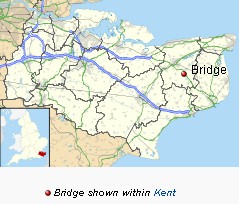 Bridge, Kent -
is near Canterbury
in Kent, South
East England. Bridge village is situated in the Nailbourne
valley in a rural
setting on the old Roman
road, Watling
Street, formerly the main road between London
and Dover , On
the edge of the village are two large country estates. Bourne Park
is a Queen Anne mansion dating from 1702. Higham Park is a large
neoclassical mansion,
Bridge, Kent -
is near Canterbury
in Kent, South
East England. Bridge village is situated in the Nailbourne
valley in a rural
setting on the old Roman
road, Watling
Street, formerly the main road between London
and Dover , On
the edge of the village are two large country estates. Bourne Park
is a Queen Anne mansion dating from 1702. Higham Park is a large
neoclassical mansion,
Same Mary Outlawe? Possibly because of the Plague? Who was Isaac Outlawe?
St. Margaret's Church, Canterbury - Parish records available at the Canterbury Cathedral Archives 1648 - 1987
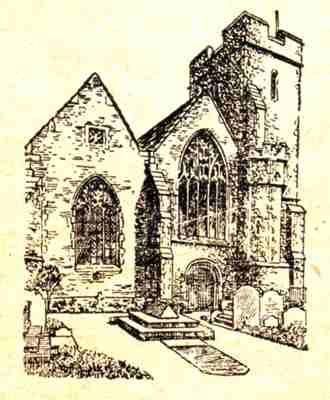 Canterbury Archaeological Trust -
Archaeology at St.Margaret's Church
Canterbury Archaeological Trust -
Archaeology at St.Margaret's Church
St. Margaret's Church now houses the 'Canterbury Tales Visitor Centre', a celebration of Chaucer's Canterbury Tales. The experience is hard to describe, you travel from room to room with
Chaucer's pilgrims hearing the tales. The Canterbury Tales web page has more details.
Canterbury Archaeological Trust - St.Margaret's Church - The earliest levels uncovered belong to the Roman public baths, a large portion of which was revealed prior to the construction of the Marlowe Arcade. The north-west end of this large building complex, located under the church, consisted of a portico with tessellated pavement fronting onto a principal Roman street. - No trace of an Anglo-Saxon church was found.
The earliest documentary reference to the church appears in a
Christchurch rental of 1153-67 in which land held by William, Priest
of Bourne, is described as being 'opposite St Margaret's Church on a corner
near the garden of Benedict the Priest'. Ceramic evidence from the excavation
suggests a possible foundation date in the twelfth century, a date supported by
the survival of the original mid-twelfth century west door of the church
(heavily restored, but fine example of its type) . Elements of the earliest
church were exposed during the course of the excavation. The north and south
walls of the early church were located inside the body of the existing church.
The original east end of the church probably extended under present St
Margaret's Street. The interior of the early church was divided into a nave with
north and south aisles defined by arcade foundations. Despite severe disturbance
by later features, particularly burial vaults, isolated 'islands' of intact
church floor survived. The earliest floors, walls and arcade bases bore
traces of an intense fire, which may have destroyed the church in the mid
twelfth century. The church was probably rebuilt at this time; the principal
walls refurbished, new arcade foundations built, a bell tower was probably
constructed at the west end of the south aisle and masonry 'benches' built
against the west wall of the nave and north aisle.
..
Considerable documentary evidence survives for the history of the church from
the mid twelfth century onwards. With the completion of the excavation, a
thorough study of these documents will immeasurably add to our knowledge of St
Margaret's Church, one of Canterbury's principal parish churches standing at the
heart of the medieval town
Canterbury - The ruins of the Norman Canterbury Castle and St Augustine's Abbey are both open to the public. The medieval St Margaret's Church now houses the "The Canterbury Tales", in which life-sized character models reconstruct Geoffrey Chaucer's stories.
Interesting we found Henry Outlawe in London 1603-1609 now I find a William Outlaw in 1614 involved with James I's clergy circle:
1601 - WILLIAM OUTLAWE matriculated Emmanuel College, 1601. - Emmanuel College, Cambridge - a college of training for Protestant preachers to rival the successful Catholic theological schools
1614 - March 6. Statement by Leonard Rountree of four articles to prove the superiority of the Protestant over the Romish faith, which were sent to him by Dr. Favour; of his replies thereto; and conversations upon them with William Outlaw, Mr. Burton, and Mr. Harwood.
1618 - Rountree, Leonard - Perpetual Vicar - St Peters, Isle of Thanet - Canturbury Kent - dies 1625 - Isle_of_Thanet - A memorial for Mr. Leonard Rowntree, minister, obt. 1624
This William maybe the son of Richard Outlawe the "noted" pursuivant (priest hunter). This record does seem to be regarding this.
Calendar of State Papers, Domestic ... - Great Britain. Public Record Office
Domestic - James I - 1614
March 6. 41. Statement by Leonard Rountree of four articles to prove the superiority of the Protestant over the Romish
faith, which were sent to him by Dr. Favour; of his replies thereto; and conversations upon them with
Wm. Outlaw, Mr. Burton, and Mr. Harwood. Imperfect. [Seemingly written from prison and for
publication.]
March? 42. L[eonard] R[ountree] to Matthew Kellison, President of [Douay] College.
Explains, at his request, his opinions on divers points of Romish doctrine and discipline. Latin.
Generally - "Mr. denotes a knighted or "a peer" person ( or an equal ) So "Mr. Harwood" maybe Sir Edward Harwood who is mentioned elsewhere. William Outlaw is probably a "gentleman" but not "a peer"
| - - - -
Mr Harwood seems to be Sir Edward Harwood who fought later for the Dutch... and seemed to be close to James I and often discussed religious matters....
Calendar of State Papers, Domestic ... - Great Britain. Public Record Office - Google Books
1617 - Sir Edw. Harwood to the Same. Lady Bedford greatly indebted to Lady Carleton for her present. Next term the Earl of Suffolk and Sec. Lake are to receive their doom; their successors are not known. Lady Buckingham still in the country, and it is thought her late honour was a preparative to retire. The Queen is better.
Dec 5
Dec. 20. Sir Edw. Harwood to the Same. The King just returned London. from Theobalds. Mr. Secretary thinks
a synod a bad way to end religious dissensions, but says the King will countenance it; so say the Archbp. of Canterbury and Lord
Chamberlain
Dec. 22. Sir Edw. Harwood to Carleton. Sounded Sec . Lake and Monday. Buckingham upon Carleton's advancement, but both are cool about n on. it. Delivered his letter to the King, who spoke much on the importance of unity in religion, and declared he would believe nothing the Armenians said, except what came direct from Carleton; that be did not, like many Princes, do his business through others, but opened all his packets himself, and none dared reply to them but by his dictation; that he approved of his Excellency [the Prince of Orange's] using all legal means to put down the Arminians, especially his calling a national synod, and would advise him to do as he himself had done, call dissentients before him to maintain their opinions in his presence. His Majesty spoke favourably of him [Carleton]. Buckingham disapproves of his wish to come over, if he come in hopes of a place; he intends to have his own kinsman, Sir Robt. Naunton, made Secretary.
1624 - Married Thomas Wright, of Ripon, and Jane Outlawe, widow, of St. Michacl-le-Belfrey, York
| - - - -- -
Arminianism -
(also called Reformed Arminian tradition, the Reformed Arminian faith,
or Reformed Arminian theology) is a school of soteriological
thought within Protestant
Christianity
based on the theological
ideas of the Dutch
Reformed theologian Jacobus
Arminius (1560–1609)[1]
and his historic followers, the Remonstrants.
The doctrine's acceptance stretches through much of Christianity from the early
arguments between Athanasius
and Origen, to Augustine
of Hippo's defense of "original
sin."
Dutch Arminianism was originally articulated in the Remonstrance (1610), a theological statement signed by 45 ministers and submitted to the Dutch states general. The Synod of Dort (1618–19) was called by the states general to pass upon the Remonstrance. The five points of the Remonstrance asserted that:
The crux of Remonstrant Arminianism lay in the assertion that human dignity requires an unimpaired freedom of the will.[2]
Since the 16th century, Christians of many sects including the Baptists (See A History of the Baptists Third Edition by Robert G. Torbet) have been influenced by Arminian views. So have the Methodists, the Congregationalists of the early New England colonies in the 17th and 18th centuries, and the Universalists and Unitarians in the 18th and 19th centuries.
Jacobus Arminius - 1 (October 10, 1560 – October 19, 1609), the Latinized name of the Dutch theologian Jakob Hermanszoon from the Protestant Reformation period, served from 1603 as professor in theology at the University of Leiden. He wrote many books and treatises on theology, and his views became the basis of Arminianism and the Dutch Remonstrant movement
| - - - - -
descendants of Sir George Harwood of London England
Sir Edward Harwood [140275] Virginia Company shareholder in Virginia before 1622 b.1586 d.11_Sep_1637
1632 Memorial to Sir Edward Harwood
Sir Edward Harwood died at the siege of Maastricht in 1632
Memorial on the east wall within the Cloister Church at the Hague, where Sir Edward has been buried.
The original text is in Latin, the monument has been erected in 1636 by Sir
Henry Herbert and Nicholas Byron
English translation by David Trim
Thou that lookes on mayest be a stranger!
Here is buried Whatever was perishable of the soldier
Sir Edward Harewood, an Englishman,
A Knight, deriving his origin from Norfolk, who under very powerful
generals, as a common soldier,
At the siege of Bommel (1599) first saw service, And was made Ensign at Ostend
(1602);
At the storming of the Rhinberg (1606)
He became Lieutenant: after that,
Of the Regiment of English commanded by the Illustrious Sir Robert Sidney
Viscount de Lisle, He was made Lieutenant-Colonel.
In Fine After serving 33 years At the siege of Maastricht
He was pierced through by three successive bullets,
and died whilst in the discharge of his duty.
That part of him which was Imperishable (that he was a man brave as well as
good, Most devoted to his God and Country)
Is handed down to the recollection and for the example of posterity, by Henry
Herbert and Nicholas Byron,
Both Knights The former Colonel, and the latter Captain in the English Army. A.
D. 1636.
| - - - - -
Mr. Burton was probably Henry Burton :
Henry Burton (Puritan) - (Yorkshire, 1578 – 1648), was an English puritan. Along with John Bastwick and William Prynne, Burton's ears were cut off in 1637 for writing pamphlets attacking the views of Archbishop Laud.
He was educated at St. John's College, Cambridge, where he graduated M.A. in 1602.[1] His favourite preachers were Laurence Chaderton and William Perkins. On leaving the university he became tutor to two sons of Sir Robert Carey.
Through the Carey interest, Burton obtained the post of clerk of the closet to Henry Frederick, Prince of Wales; while acting in this capacity he composed a treatise on Antichrist, the manuscript of which was placed by the prince in his library at St. James's. He complains that Richard Neile, who was clerk of the closet to King James, opposed his advancement; however, on Prince Henry's death (6 November 1612) Burton was appointed clerk of the closet to Prince Charles. On 14 July 1612 he had been incorporated M.A. at Oxford, and was again incorporated on 15 July 1617. He tells us that at the age of thirty (i.e. in 1618) he resolved to enter the ministry. Thomas Fuller says that he was to have attended Prince Charles to Spain (17 February 1623) for the Spanish Match, and that for some unknown reason the appointment was countermanded.
Clerk of the Closet - Clerks of the Closet in other Royal Households
| - - - -
1624 - Married Thomas Wright, of Ripon, and Jane Outlawe, widow, of St. Michacl-le-Belfrey, York ( possible connection to Dr. John Favour )
St Michael le Belfrey, York - The present church building was built between 1525 and 1536 and replaced a church that dated back to at least 1294.
The church is famous for being the place where Guy Fawkes was christened on 16 April 1570 Fawkes was christened an Anglican but later converted to Catholicism which led to the failed 1605 Gunpowder Plot
Fountains Abbey - is near to Aldfield, approximately two miles southwest of Ripon in North Yorkshire, England. It is a ruined Cistercian monastery, founded in 1132. Fountains Abbey is one of the largest and best preserved Cistercian houses in England.
| - - - - - - - -
John Favour - (d. 1624) was an English divine.
Favour was born at Southampton, and was sent to Winchester College, whence he was elected probationer fellow of New College, Oxford, in 1576, and in 1578 was made complete fellow. In April 1584 he took the degree of LL.B.[1], proceeding LL.D. on 5 June 1592 (ib. i. 258). In January 1593–4 he became vicar of Halifax, Yorkshire.
In August 1608 according to Thoresby[2], but in March 1618 according to Wood, he was made warden of St. Mary Magdalen's Hospital at Ripon, Yorkshire. He was made prebendary of Southwell in 1611 and of Osbaldwick, York, in 1614. In March 1616–17 he was collated to the prebend of Driffield and to the chantorship of the church of York. He was also chaplain to the archbishop and residentiary.
Century of Revolution - A Puritan stronghold, Halifax suffered occupation by both Royalist troops after the Royalist victory at Adwalton Moor in 1643 and by Parliamentarian forces after the Royalist defeat at Marston Moor.
Dr John Favour’s energetic and inspiring ministry as Vicar of Halifax from 1593 to 1623 promoted the growth of Puritanism in the parish and an upsurge in charitable bequests including the endowment of Heath Grammar School
| - - - - -
Leonard Rountree was a Jesuit priest that went over to the Church of England..... A propaganda tool
Leonard Rountree - Conversion, politics, and religion in England, 1580-1625 - Michael C. Questier
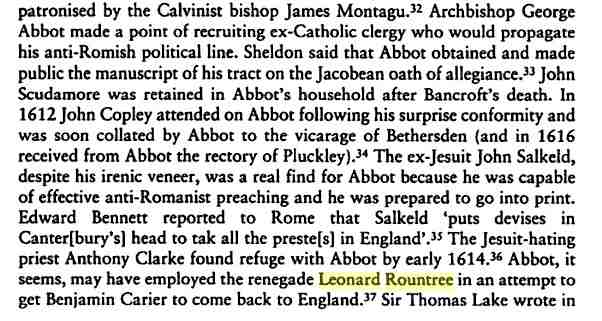
So just to recap I have found two possible original fathers of Captain John Outlaw and Edward Outlaw
Henry Outlawe - Gentleman - Blackfriers playhouse - London - 1603-1609
William Outlaw - King James I Domestic papers - London - Clergy puritan
with Henry Burton "clerk
of the closet" to Prince
Charles in 1614 (this may have been the son of Richard Outlawe the
Pursuivant.)
However since both John and Edward were involved with ships and ship building I think the father was probably was someone else (possibly from Stepney or Bridge Kent)_. There was plague at the time and we have Mary Outlawe as widow, we might presume she had children.
1601 - WILLIAM OUTLAWE matriculated Emmanuel College, 1601.
1602 - Smyth, John, of Bridge, and Mary Outlawe (widow), Nov. 27 -Canterbury marriage licences
1603/4-1609 - Henry Outlawe deposes on Edward Kirkham's behalf that for a total of fifteen weeks between 1603 and 1604, Henry Evans collected 30s a week 'for the use of stools standing upon the stage at Blackfriars.' Outlawe does not believe that Evans gave account of this income to the rest of the sharers. - Blackfriars - St Anne's - London - English professional theatre, 1530-1660
1609 - William Vynor & Mary Outlawe - Dec 19 - Marriages at St. James - Clerkenwell
St James's Church, Clerkenwell
- Old Church of St James: 1540 - 1788 - At the dissolution of the nunnery under Henry VIII its church, which by then seems to have
acquired a second dedication to St James, was taken into use by its parishioners who had already been using a part of it for some considerable time.
The site of the nunnery was granted to Thomas Howard, 3rd Duke of Norfolk in 1540 but the freehold of the church passed through various hands until it was conveyed in 1656 to trustees on behalf of the parishioners, who at the same time obtained the right to appoint the vicar. Unlike other parishes, they retained it after the Restoration of 1660.
- The Monastic Order of the Knights
Hospitallers of St
John of Jerusalem
had its English
headquarters at the Priory
of Clerkenwell.
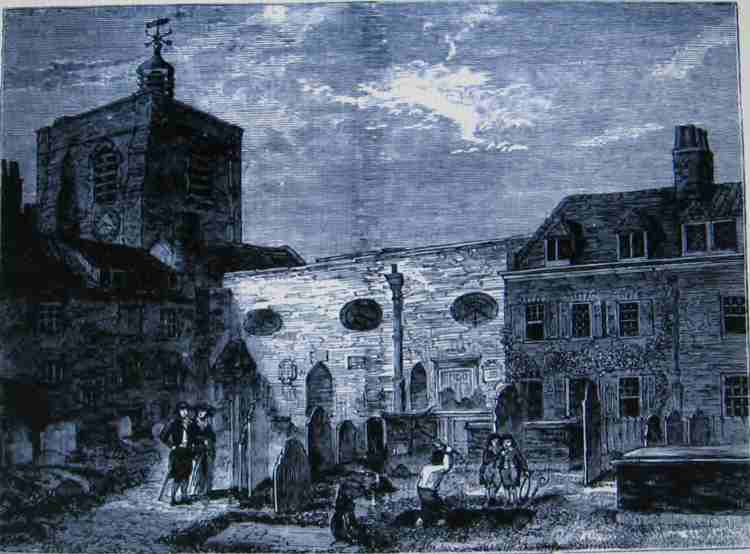
The National Archives Access to Archives - Sched excom - They seem to be clustered in 1609 1614 and 1617
1614 - March 6. Statement by Leonard Rountree of four articles to prove the superiority of the Protestant over the Romish faith, which were sent to him by Dr. Favour; of his replies thereto; and conversations upon them with William Outlaw, Mr. Burton, and Mr. Harwood.
1617 - Sched excom: Thos OUTLAWE Bridge Kent; non-appearance - 6 May 1617 - Canterbury Cathedral [ A Puritan! ]
Notice this! Puritans were being excommunicated from the church of England. Many left for Holland and then on the Mayflower:
Mary Chilton
-
1609, James wife was excommunicated from St. Peter's Church, Canterbury,
England
1610, Moved to Leyden, Holland to escape religious prosecution
1620, James and wife were passengers on Mayflower
James Chilton - (c. 1556 – 18 December 1620) was an English Separatist who came to America aboard the ship Mayflower. He was a signer of the Mayflower Compact, and was probably the oldest Mayflower passenger. ... James Chilton died on 8 December 1620, while the Mayflower lay anchored in Provincetown Harbor
The first evidence that the Chilton family had its own Separatist views appears in 1609. In late April, Chilton's wife was among four people that secretly buried a dead child, without having the Church of England perform its mandatory burial rites. When the burial was discovered, the group rejected the need for the mandatory rites, calling them "popishly ceremonies and of no other force." For this defiant act, Chilton's wife and two of the others were excommunicated from the Church of England on 12 June 1609
1624 - Married Thomas Wright, of Ripon, and Jane Outlawe, widow, of St. Michacl-le-Belfrey, York
| - - - - - - - -
To continue with the Mayflower connection to the Outlawe's (we seem to be one connection removed and more connected to the Virginia Colony company)
The Finding of the Mayflower
- The Fourth Owner of the "Mayflower" Found.
We have shown in what precedes that the Jordans farm with its attached ship-built barn was the property
of the Gardiner family, and that it passed from them to the Russell family at some time in the middle of the
seventeenth century ; and we have suggested that there may have been some connection between
the Gardiner clan and a certain Richard Gardiner who sailed in the 41 Mayflower ". At this point we find ourselves in
difficulties ; for the name Gardiner is a common one, but the Gardiner clan, whom we have been detecting among
the owners of Jordans farm, does not crop up in the Chalfonts, in the same way as the Child clan does in the
district round Amersham. We must go outside the county in search of their ancestry.
We showed in the previous chapter from an inquisition made on 21 January, 1541/2 that William Gardyner was at his death the owner of the Manor of Grove Place and, amongst other properties, of the Jordans farm
Brothers = John Newdigate, Frances Newdigate, and James Bacon, William Godolphin,
Brothers- John Gardiner, Thomas Newdegate, in-law Antony Newdegate, Nicholas Newdegate, Robt. Newdegate.
Cousin = Richard Crayford, to whom the testator
Witnesses ; John Newdegate, Edward Baber, Thomas Newdigate, John Gardiner, Will. Godolphin,
John Greene.
Date of Probate : 26 Nov. 1561.
1543 - Westminster., 19 Feb. showing Sir Francis Bryan that the King is advertised of the troubles we were in upon the seas and the danger and ruin of his ships, and that I was determined according to your commandment to send four ships to the Downes. The said ships were ready in Humber before the receipt of your letters, whereupon I sent a boat which has spoken with Mr. Clere and Mr. Carye, commanding them to lie off and on upon the coast between Humber and Newcastle, and as Mr. Nedygate and Adam Owtlawe were ready victualled I thought it more convenient that they should accompany Mr. Clere and Mr. Carye, than lie in harbour.
Mr. Nedygate is probably Thomas Newdegate - a relative of John Newdegate Esq. of Harefield, (or more likely his son John Newdegate Esq.) born 6 Henry VII; dying in 1545 was succeeded by his eldest son. John Newdegate Esq. of Harefield MP for Middlesex in 1571, 1573, 1574
An interesting find - a monument a Outlaw's Bridge - Duplin - dedicated to Capt James Outlaw of the Revolutionary War.
1936 - Capt. James Outlaw Monument - Outlaw's Bridge - Duplin North Carolina - May 5
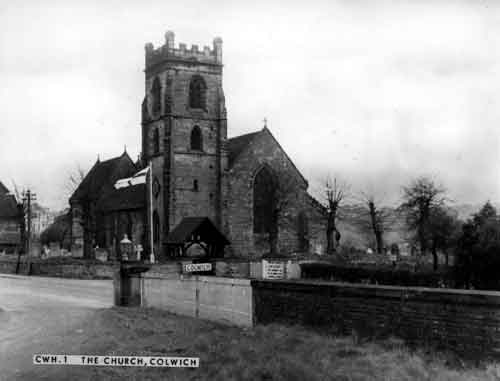 Full text of Collections for a
history of Staffordshire
Full text of Collections for a
history of Staffordshire
1377 - PRIESTS. John Morcell, Wm. Fletcher, John son of Wm. Utlawe, Ric. Godeberd. Oct. - Prebendal Church of Colewych - Colwich, Staffordshire
History of Colwich, in Stafford and Staffordshire Map and description
GENUKI Colwich - "Colwich Church is an ancient edifice, dedicated to St Michael, and contains a number of monuments belonging to the Anson, Wolseley, Sparrow and other families. The burial place of the Ansons is in the shape of a catacomb, in one of the five compartments of which are walled up the remains of that celebrated admiral and circumnavigator, the first Lord Anson.
The Chapel of St.Chad was built before 900AD while the De Colwyches lived here.
1560-1 - Letter of attorney of Peter Walle, clerk, made to John Outlawe. Oath book of Colchester
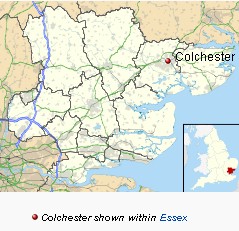 Colchester
- is an historic town and the largest settlement within the borough
of Colchester in Essex,
England.
Colchester
- is an historic town and the largest settlement within the borough
of Colchester in Essex,
England.
Between 1550 and 1600, a large number of weavers and clothmakers from Flanders emigrated to Colchester and the surrounding areas.[29] They were famed for the production of Bays and Says cloth. An area in Colchester town centre is still known as the Dutch Quarter and many buildings there date from the Tudor period. During this period Colchester was one of the most prosperous wool towns in England, and was also famed for its oysters.[29] The old Roman wall runs along Northgate Street in the Dutch Quarter.
Lets go back to the name spelling variations again:
Middle English Dictionary O.4 - Robert E. Lewis
Thomas le Utlaghe (1273)
Ricardus le Houclawe (1279)
WIward Hutlawe (1288)
Thomas Utelagh (1297) Thomas Utelagh (1301)
Waltero Ughtlawe (1317)
Isabell Outlagh (1327)
Ric. Utlaghe (1332)
Joh. Outelagh
Galfr. Vtlawe
Walt. Uttlag (1393)
Johannis Owtelawe c1400
Alanus Vtlage
Vtlawe
Statutes of Lincoln Cathedral Part 2. - Lincoln Cathedral, Henry Bradshaw, Christopher Wordsworth
1437 - Vtlawe John, chaplain - Lincoln Cathedral
Johannes Vtlawe, capellanus cum precentore exhibet literas etc., et examinatus dicit quod laborant publica vox et fama quod dominus Robertus Swaby est communis et publicus talorum frequentator et aleator.
Vtlawe John, chaplain, etc. with letters precentore pays., And examined and the fame of the voice of the public that our
Lord Robert Swaby says that labor is common and the public and much frequented talorum GAMBLER.
1389 - Richard Outelawe, and Joan his wife, Cantebriggie town, diocese of Ely. - St Mary's Gild - Cambridge - Jan 31 1389
Outelawe Richard, and Joan his wife, Cantebriggie town, diocese of Ely, Greeting in the Lord
1279 - Isabella Hutlawe holds of William Muschet one messuage with a croft adjoining by the service of - Horningsea - Cambridge - HORNINGSEA village - 5 miles north of Cambridge, between Fen Ditton and Waterbeach
Horningsea - The village has been home to a place of worship for well over a thousand years. The Saxon's chose the site for a minster in the 9th century, though it was sacked by the invading Danes in the 870s and rebuilt soon after. Only a pair of Saxon coffin lids remain from the original church.
The south arcade remains from the 11th century, the chancel from around 1220, and the building was substantially rebuilt in the 13th and 14th centuries. During this period it was granted to the Hospital of St John in Cambridge, that later became St John's College. It was extensively restored in the early 19th century
Thomas Outlawe - 1548
1548 - Thomas Outlawe - King Edward VI. issued a proclamation, A. D. Oct. 1548 - accused of piracy - 300 crown reward
The social history of the people of the southern counties of England in past ... - George Roberts
King Edward VI. issued a proclamation, A. D. Oct. 1548, against sundry lewd and evil-disposed persons who had become pirates and had robbed the king's own merchants and others the subjects of friendly powers. They had taken sailors and others out of ships, and had compelled them to serve against their will. Their names follow, and the reward offered for each, quick or dead.
John Thompson 1000 crowns; Richard Cole, 600; Thomas Freeman, 400; David Poore, 300; Morrice Kelly, Richard Eyre, Patrick King, Thomas Outlawe, and Michael James, each 300 crowns reward.
[ It is interesting that the Thompson's and Outlawe's were partners together at Lynn with the Hanse Trading:Guild 90 years earlier:
]
Crawford-bib Ryl Tudor V1 - Oct. 1548
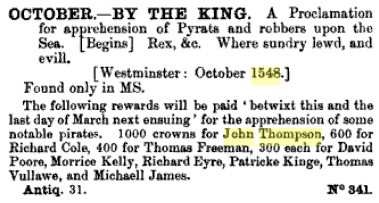 Notice the Thomas Vullawe spelling...
Notice the Thomas Vullawe spelling...
300 each for David Poore, Morrice Kelly, Richard Eyre, Patricks Kinge, Thomas Vullawe, and Michaell James.
| - - - -
This is the first sign of any piracy... So this is very interesting with a connection to Thomas Seymour , it is possible that this Thomas Outlawe was related to the earlier Adam Outlawe (son?) - mariner in the 1544 Calais campaign and was working for the High Admiral as a pirate between Ireland and Cornwall/Bristol . It is interesting - Where did they get the names of these "Notable" pirates?
Thomas Seymour, 1st Baron Seymour of Sudeley - ... Thomas also bribed a man called John Fowler, one of King Edward VI's closest servants, from whom he received information that the King frequently complained about the lack of pocket money he received. Thomas smuggled money to the King and began to voice open disapproval of his brother's administrative skills. As Lord High Admiral, he was able to control the English navy, and he openly asked people for support in case of a coup. As admiral, he also encouraged piracy, after bidding to capture the pirate Thomas Walton (Pirate), Thomas Walton instead made an agreement for a share of all booty seized by him. He was completely and thoroughly indiscreet in his bid for power.
Then there's Mary Seymour who for a time was held at Wexford Ireland:
Mary Seymour - ... Mary was also believed to have been removed to Wexford, Ireland and raised under the care of a Protestant family there, the Harts, who had been engaged in piracy off the Irish coast under the protection of a profit sharing arrangement with Thomas Seymour.[citation needed] A lozenge-shaped ring inscribed "What I have I hold" reputed to have been an early gift to Thomas by his brother Edward passed down through her descendants the Seymour-Harts up to at least 1927.
History of Cornwall
...
The war of 1543 was opportunity for an outburst of privateering so successful
that it alarmed the king, who was compelled finally to order that all
privateering from Cornwall, Devon, and Dorset
should be stopped, and all privateers at sea should be recalled, in consequence
of the plundering of the emperor's subjects.1
This may have been advisable for political reasons, but if the privateersmen
were taking French goods out of imperial ships, it does not follow that they
were doing anything illegal. It was no doubt a man of this class who had
invested his savings in a maritime speculation who is described as the owner of
an inn at Falmouth, and further as a pirate.2
Another respectable delinquent was a burgess of Penzance, and in many of
these cases of notable piracy and disorder,' the culprits were given the
option of paying the claimants the value of the property seized, which shows
that the offences were more civil than criminal. That real piracy existed and
increased after the death of Henry VIII is not surprising in view of the
European turmoil that lasted half a century, the weakness of the government,
and, frequently, the secret encouragement of underhand practices.
Thus in 1548 relations with France were very
strained, and the authorities in Devon and Cornwall were
directed by the Privy Council to encourage shipowners to equip privateers to
seize French ships on the plea of retaliation, pretending' that they had
formerly lost goods themselves and could obtain no redress in the French courts.3
In the event of peace continuing the captors were to return the cargoes and have
their expenses paid by the government. Both parties must have understood this
promise as the homage that vice pays to virtue.
In the following year the Lord Admiral, Lord Seymour, was beheaded for reasons of state, and amongst the articles of accusation were several charging him with dealings with pirates, 'as though you were authorized to be the chief pirate and to have all the advantage they could bring unto you.'4
July 15, 1548 - Kinsale Ireland
Sovereign and Council of Kinsale to same. Had received his letters of the 14th July. All their men died of the pestilence, and they have a wide empty town, few men, and naughty neighbours. Their haven is stopped by Eagle's pirates, who will not suffer any victual to come to them. Now of late came one Richard Colle, a pirate, with a pinnace, and has married Barry Oge's aunt, and dwells in his castle, and will not suffer any to come to the town.
July 31, 1548 - Waterford Ireland
Mayor, &c., of Waterford to the Lord Deputy and Council. Waterford. Announcing the arrival of Tomson, the pirate, in their port, who threatens to do them mischief for the taking of his boy by Watkin ApowelL
August 9 1548 - Waterford Ireland
Mayor, &c., of Waterford to the Lord Deputy. Certain Waterford. Portingales have arrived with the Lord High Admiral's warrant for delivery of certain goods of theirs that had been seized under suspicion of piracy. A servant of the Admiral's has since arrived with a letter of a later date, directing the ships and goods to be given up to him. Inclose,
Lord High Admiral Seymour to James Walsh, Mayor of Waterford. To deliver up a bark lately belonging to Richard Coles [R. Colle?], of Myneth, to the bearer, his servant, Thos. Wodloke. July 19, Sudeley Castle.
[ Sir Francis Bryan marries the widow Joan FitzGerald (Desmond) Dutchess of Ormond and goes to Waterford Ireland (Clonmel/ and Kinsale?) in 1548 and on arrival is made Lord Marshal of Ireland:
Joan Fitzgerald, countess of Ormond and Desmond (c. 1514-1565). Joan's significance and influence stemmed in part from the fact that she was the daughter of the 11th earl of Desmond and the wife of three powerful men, James Butler, 9th earl of Ormond, Sir Francis Bryan, Lord Justice of Ireland and Gerald Fitzgerald, 15th earl of Desmond
Joan Fitzgerald, Countess of Ormond - Lady Joan was born in Desmond Castle, Kinsale, County Cork, Ireland in about 1509[4] or 1514,[5] the daughter and heiress-general of James Fitzgerald, 10th Earl of Desmond and Amy O'Brien. ... she was persuaded to marry the English courtier and diplomat Sir Francis Bryan in August 1548. He was appointed Lord Chief Justice of Ireland and the couple returned to Ireland in November 1548, where she had a son Sir Francis and a daughter, Elizabeth
Francis Bryan was born June 1, 1490 in Munster, County Clare, Ireland and
died Feb 2, 1550 in Clonmel,
Tipperary, Ireland.[ possibly piosoned] He was Chief Gentleman for the Privy Chamber for Henry VIII of England.
Sir Francis Bryan married Joan Bryan, Duchess of Ormond (born Fitzgerald), they had two sons, Francis "Justice of Ireland" II and Edward Bryan, Lord of Upper Ossary. Francis Bryan I parents were Thomas "Thomas de Bryan" III and Margaret Bryan (born Bourchier).
1548 - Sir
Francis Bryan, Lord
Marshal in Ireland. - Oct
The making of Ireland and its Undoing - Alice Stopford Green
RAIDS ON IRISH TRADE ...
... with the rapid growth of English shipping under Henry VIII the merchants took in hand themselves to capture the Irish trade. Pirate vessels hung round the coasts—ships of sea adventurers, Smiths and Thompsons, Whiteheads and Stevensons, and the like, between whom and the southern towns there was animated war.1 They defied the town rulers, and made war on the Spanish and French traders with the Irish ports. Kinsale complained that Eagle's pirates stopped its haven, 1548 and would allow no victuals to come to its people. One of them "dwells in the Castle and will not suffer any to come into the town." Many English adventurers, it was told, do much harm to Cork and the whole line of coast: they haunt the haven mouth, and will be like enough to take them over. They terrified the mayor so 1549 that he feared to make variance between Cork and the pirates without special commandment, and meanwhile they were refreshed with victual and were making of ordinance within the city.
The Duke of Somerset was Tom Seymour's brother "Edward Seymour"
Edward Seymour was the senior political figure in the reign of Edward VI before he was levered out of power by John Dudley, Duke of Northumberland. Edward Seymour, regardless of his loyalty to the king, was executed for conspiracy in 1552.
England under Protector Somerset an essay - Albert Frederick Pollard
Seymour used his position as Lord High Admiral for the same disgraceful ends, and with even more prejudicial effects to his country. When he was appointed to the post he said he was as glad of that as of any, because it gave him command of ships and men. This influence he proceeded to employ for the furtherance of his private ends to the complete neglect of his public duties. One of the most important of these was the suppression of the pirates who swarmed in the English, Irish, and Bristol Channels, but instead of doing so, Seymour entered into an agreement with the pirates to connive at their proceedings on condition of receiving their support and a portion of their stolen goods.
Early in 1547 Thompson of Calais, a notorious freebooter, who had been "wanted" more than once under Henry VIII, and had always escaped, seized the Scilly Islands and intrenched himself in this advantageous position. The Protector sent Seymour with a much superior force to dislodge him, but the Admiral left him unmolested, having, it was believed, come to an understanding with Thompson to share his plunder and the control of the islands. Lundy Isle was used for the same purpose, and the Admiral pursued this policy even in the Admiralty Courts, protecting those who were accused of piracy, and denying redress to their accusers.
This brought him into collision with his brother's authority, but other effects were more serious. Not the least of the causes of French irritation was the continual risks to which their merchants were thus liable. Odet de Selve admits that the Protector issued commissions for the seizure of the pirates, but complained that they had no effect, and he began to disbelieve the good faith of the English Government.
| - - - - - -
Should I be searching for "Lawless" in Ireland and elsewhere?
County Kilkenny Surname Histories
...
Bryan - Bryan is likely of Anglo-Norman
origin. It is possibly derived from the Christian name Brian, usually regarded as essentially Irish, which was common in France and in mediaeval England. As a result there is much confusion with the Irish O'Byrnes.
Almost all the Bryans who have been recorded as members of parliament, army officers, mayors etc. and landowners have been Kilkenny
people. MacLysaght cites their ancestors arriving in the 13th century, although the name is practically absent from the earlier records in the Calendar of Ormond Deeds.
A Sir Francis Bryan is cited, in an Ormond deed dated January 1548/9, as "knight, gentleman of the King's privy chamber." In the same deed Lewis Bryan of Dammagh is mentioned, and he is cited by other sources to have held Whiteswall and Bawnmore as well. This family of Bryans claimed to be descended from old English stock, the de Brienne family. Canon Carrigan states in his history that John Bryan, Esq., of Kilkenny, was descended from the Bryans of Whiteswall, "auntiently called Byrne," and that Jenkinstown came into the possession of the Bryan family, sometime after 1638, upon John's marriage to Annes Stanes. In the 1659 census of Co. Kilkenny, the name Bryan is noted as a principal Irish name in the baronies of Gowran and Ida. In 1878 George Leopold Bryan, of Jenkinstown House, Co. Kilkenny, owned 12,891 acres, other
Bryan estates, mainly in Counties Wexford and Kilkenny, amounted to another 13,000 acres. The 1890 census in Kilkenny noted 15 births under the name Brien.
...
Lawless - Though the surname Lawless is formed from the
Old English word laghles meaning an outlaw, it may, as far as Ireland is concerned, be regarded as falling in the Anglo Norman category.
Outlawe was itself a not uncommon surname in Ireland in the middle ages, e.g. Roger Outlawe, prior of the Hospital of St. John of Jerusalem in 1337, and Henry Outlawe, sovereign of Kilkenny in 1312.
From soon after the invasion the name (written Laweles, Laghles, Lachles, Laules, etc). appears frequently in mediaeval records up to the end of the sixteenth century throughout Leinster and Munster, particularly in Co. Kilkenny. One branch settled in the city of Kilkenny in the fourteenth century: Walter Lawless was mayor of Dublin, his family being landowners at Cabra and elsewhere near the city. Petty's "census" of 1659 indicates that in the seventeenth century they were fairly numerous in Co. Kilkenny and the Dublin area. In that record the name Laules was a principal Irish name in the Kilkenny barony of Ida. They were nearly all staunch Jacobites and among the exiles after 1691 was Patrick Lawless who became Spanish Ambassador to London in 17136 and afterwards to Louis XIV of France. Walter Lawless was confiscated of his lands in Kilkenny about 1702 following the Williamite war. The name Lawless still appears in the Kilkenny record of the mid-19th century, although in much smaller proportions than the other counties it is noted in, particularly Dublin.
| - - - - - - -
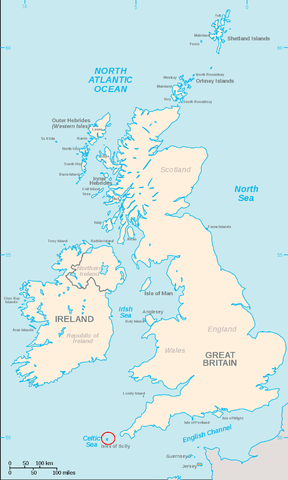 The Pirates of the Channel.
1548
The Pirates of the Channel.
1548
Complaints came frequently before the Admiralty. Occasionally one of the vessels was taken, the crews were handed over to Seymour for justice, and the recovered cargoes were set apart to be restored to their owners. But the merchants, foreign and English, were exasperated to find that neither were the goods given back to them nor the offenders punished. Ornaments known to have been plundered were seen on the persons of the admiral's followers.
Notorious pirates brought in by the king's cruisers were set at liberty by his
order; and suspicions went abroad that Lord Seymour was attaching them to himself for services on which he might eventually require their assistance.
He was found to have made a purchase of the Scilly Isles, that they might be undisturbed in their favourite
haunt; or that, if he failed in his larger schemes, "he might open a new career to himself of revenge The master and pillage as a pirate chieftain
[ With whom he enters into an understanding, And buys the Scilly Isles, their general rendezvous.]
...
Sympathizing readers will be glad to know that these pirates came duly to a becoming end. On the
25th of the same month of July 1548, a large French vessel with a hundred hands came into Kinsale
harbour. Richard Colle attempted to take her, but failed; his crew, if not himself, were taken instead, and were disposed of on the yard-arm
Isles of Scilly
- form an archipelago off the southwestern tip of the Cornish peninsula of Great Britain.
The Encyclopædia britannica
... the family of Blanchminster (de Albo Monasterio), at the beginning of the 14th century,
held of the earldom of Cornwall lands in Scilly at a yearly service of 6s. 8d. or 600 puffins
In 1547 Silvester Danvers, as representing the Blanchminsters, being one of the coheirs,
Sold his moiety of Scilly to Sir Thomas Seymour, by whose attainder, in 1549 this and probably the other moiety
fell to the crown.
| - - - - -
As an update I haven't been able to find any other reference to this Thomas Outlawe of 1548... Still looking....
... The first pirates on the English coast were themselves English, and preyed as a rule on foreign shipping. Englishmen who were originally naval seaman, privateers in Queen Elizabeth’s navy fighting the Spanish
A certain Peter Killigrew, was charged with piracy in Ireland in 1555 and
was under examination in the Tower in 1556. The same gentleman was fined
£55 for "dealing with pirates and pirates goods" in 1578. The most
extraordinary member of this family was, however, John Killigrew, Captain of
Pendennis Castle. In 1577 he was found to have purchased stolen French wines
from a pirate named Hix, but was allowed to settle the matter by paying the real
owners for the goods.
...
An official enquiry into piracy in Devon and Cornwall appears to have been
made late in 1563.
...
In the 1630’s piracy was at its worst (it was at this time that the
worst piratical attack on St. Keverne took place) and that in his great work of
perfecting the navy Cromwell provided the means for the final crushing of
piracy.
...
Islands played a big part during the golden age of piracy. Piracy flourished on
the Isles of Scilly since the Middle Ages....In Charles I reign in the 1640s
many pirates based themselves there....
Somerset - Thomas Wyndham 1510-1553
Wyndham was wealthy and helped lead a syndicate of raiders in the west of England.
In 1545 and 1546 he looted a Spanish ship and a Portuguese ship and was prosecuted and fined. In 1551 he started trade with Morocco and later sailed to West Africa looting villages and Portuguese ships.
He died there of fever.
1601 - Elizabeth Owtelaw
of Norwich marries Thomas Jellis parson of Ellough Suffolk - Aug
10 - Ellough
1603 - Thomas
Jellis parson of Ellough - Widower of Elizabeth Owtelaw - marries Marye
Searles - Nov 21
The parish registers of Ellough, Suffolk - Frederick Arthur Crisp
1601 Aug. 10 Thomas Jellis parsone of Ellowghe singleman and Elizabeth Owtelaw of Norwich singlewoman were
married in Norwich aforesaid in the parish church of S' Johnes marter markett the Tenth daie of August By
Mr Batho. preacher there
Interesting reference to the Outlawe Arms: (wonder where the book is now...)
Book-lore a magazine devoted to old time literature, Volume 3
THE WODHULL LIBRARY (sale Jan 1886)
."—Plauti Comaediae emendatae per Georgium Alexandrinum (Merulam), first edition, folio, Venetiis, Vindolinus de Spira, 1472, fine large copy, with initial letters and arms of the Tornabonii, illuminated in gold and colours, bound in maroon morocco, with arms of Outlawe of Witchingham, Norfolk, in gold on sides; £30 (Quaritch). For this Mr. Wodhull paid Payne £20 in 1798
1639 - Admission Lincoln's Inn - Thomas Outlawe, son and heir app. of Ralph Outlawe, of Witchingham Parva, Norfolk, gen. - Feb 6 - Lincoln's Inn
Interesting at the same period:
1638 - Richard Kennedy, 2nd son of Robert Kennedy, of City of Dublin, Arm. [Ireland, knt. Aug 25
| - - - -
WILLIAM PRYNNE.
William Prynne's name occurs for the first time in 1627. He was then a Student of the Society, and had published a book (now in the Library) entitled " The Perpetuity of a Regenerate Man's Estate." The Commissioners for matters Ecclesiastical summon him before them for divers passages in the book, tending to the great scandal of the Church of England, and apply to the Bench to give him notice of the summons. The result of these proceedings, which have hitherto escaped notice, is unknown. In 1634, being an Utter Barrister, he was censured in the Star Chamber, for the publication of the " Histrio Mastix," and ordered by the Court to be expelled from the Society: the Bench complied with this order in April, 1634, determining after consideration to retain the books he had presented to the Library. In
1641, in pursuance of an order of the House of Commons, the Bench restore him "to his former condition in the House according to his antiquity and to his chamber there." Later on he is discharged of all arrears on the Preacher's Roll which had accrued while he was a prisoner. He was called to the Bench in 1648, and in 1657 he was appointed Treasurer of the Society.
William Prynne
- (1600 – 24 October 1669) was an English
lawyer, author, polemicist, and political figure. He was a prominent Puritan
opponent of the church policy of the Archbishop
of Canterbury, William
Laud. Although his views on church polity were presbyterian,
he became known in the 1640s as an Erastian,
arguing for overall state control of religious matters. A prolific writer, he
published over 200 books and pamphlets
...
On 14 June 1637 Prynne was sentenced once more to a fine of £5,000, to
imprisonment for life, and to lose the rest of his ears. At the proposal of
Chief-justice John
Finch he was also to be branded
on the cheeks with the letters S. L., signifying 'seditious libeller'.
Prynne was pilloried on 30 June in company with Henry
Burton and John Bastwick, and Prynne was handled barbarously by the
executioner. He made, as he returned to his prison, a couple of Latin verses
explaining the 'S. L.' with which he was branded to mean 'stigmata laudis'
(("sign of praise", or "sign of Laud").[4][8]
His imprisonment was then much closer: no pens and ink, and allowed no books except the Bible, the prayer-book, and some orthodox theology. To isolate him from his friends he was removed first to Carnarvon Castle (July 1637), and then to Mont Orgueil Castle in Jersey.
| - - - - -
The English reports Volume 4; Volume 85
Cook Vs. Gerrard - 16 Charles II regis - 1665?
...
Gideon Cook complains of Sir Francis Gerrard Knight, being in the
custody of the marshal of the Marshalsea of our lord the King, [171] before the
King himself; for that whereas one Thomas Kempe on the 20th day of October,
in the 16th year of the reign of our Lord Charles the Second, now King of
England, &c. at Finchingfield, in the said county, had demised, granted, and
to farm let to the said Gideon, six messuages, six cottages, one water
corn-mill, one windmill, 360 acres of land, 40 acres of meadow, 200 acres of
pasture, and 100 acres of wood, with the appurtenances, in Finchingfield
aforesaid, and Sampford Parva, in the said county; to have and to hold the said
tenements with the appurtenances to the said Gideon, from the Feast of St.
Michael the Archangel then last past, unto the end and term of five years thence
next following, and fully to be complete and ended; by virtue of which said
demise the said Gideon entered into tho said tenements with the appurtenances,
and was thereof possessed until the said Francis afterwards, to wit, on the day
and year aforesaid, with force and arms, &c. entered into the said
tenements with the appurtenances, in and upon the possession of him the said
Gideon thereof, and ejected, expelled, and amoved him the said Gideon from
his said farm, his said term therein being not ended, and him the said
Gideon from his said possession thereof has kept out, and still keeps out, and
other wrongs to him did against the peace of our said lord the now King, and to
the damage of him the said Gideon of 51.: and therefore he brings suit, &c.
...
...after the decease of the said Thomas Kempe, I will, give, and devise the same
premises to Thomas Kempe, eldest son of the said Thomas Kempe, by Elizabeth
his now wife, for the term of his natural life, doing no strip or waste; and
after his decease, to the heirs males of the body of the said Thomas Kempe, the
son lawfully to be begotten; and for default of such issue, to the use and
behoof of the heirs males of Thomas Kempe the father, lawfully begotten or to be
begotten; and for default of such issue, then to the use and behoof of the right
heirs males of me the said Sir Robert Kempe for ever. And my further will
and mind is, that the said Thomas Kempe and his heirs respectively, in
consideration of the devise aforesaid, immediately from and after the decease of
Ruth Kempe my daughter-in-law, shall [176] pay unto my godson Robert Outlaw,
out of the rents and profits of the jointure-lands of the said Ruth Kempe, for
and during the natural life of him the said Robert Outlaw, one annuity or
yearly rent-charge of twenty pounds per annum, by half-yearly payments, at
LadyDay and Michaelmas yearly;
...
... and unto Elizabeth Outlaw, the daughter of my nephew Thomas Outlaw, the sum of twenty pounds per annum, by half-yearly payments, at Lady-Day and Michaelmas yearly, during her natural life.
Captain Thomas Outlaw - The Blessing of London Ship - 1661 Boston
1661 - Captain Thomas Outlaw - The Blessing of London - Boston
So this Captain Thomas Outlawe may have been the father of Edward and Capt John Outlaw
New:
| - - - - - -
1609 - The
Blessing to Virginia
1614 - The Blessing
ship, with 100 passengers arrived in Bermuda.
1633-35 - The Great
Migration: Ships to New England 1633-35
1635 - Details the roll of passengers of
The Blessing, which sailed from London, mid-July, 1635, bound for New England. The ship arrived safe at
Massachusetts Bay - J
Lester, Master
1636 - Providence
Island Company - Capt Robert Hunt was chosen for The Blessing in May 1636
Captain William Rous - In 1636, he was given a privateering commission and letter of marque by the PIC. In command of the Blessing, and accompanied by a pinnace, he and the Expectation had planned to attack Santa Marta. However, when the Expectation was becalmed, he instead entered the harbor alone on October 20, 1636. The Spanish had been warned of his attack and were prepared for him when he arrived. Losing several men, Rous and the others surrendered after a brief fight and taken overland to Cartagena where he and his crew were imprisoned. Transported to San Lucar, Spain, he was eventually released due to the efforts of the English ambassador. In 1642, he left England to joined William Jackson as an officer in his privateering expedition to the West Indies. Including privateers such as Samuel Axe and Lewis Morris,[3] Rous spent the next three years raiding Spanish settlements throughout the Caribbean, including participating the conquest of Jamaica in 1644
1637 - March
29 London - The Company of Providence Island to the Governor and Council.
Are glad that the Blessing and
Expectation have safely arrived.
1637 - William Browne in
The Blessing to Virginia in 1637. The ship Blessing made several trips to Virginia and John Sibsey was a freighter in this ship on occasion. Servants named Edward Cooper, John Moore, and Jobe Seamore are also mentioned in court records as having arrived in the Blessing in
1637 (Ivey Family)
1652 - James. Reed and Thomas Carricke owner's, of the shipp Blessing of London are debtors.
1655 - the bark
"Blessinge" left Bermuda for Barbados, owner Anthony Peniston. She again sailed for Bermuda
(Burmudos) from Barbados in September 1679 under Francis Wellington commander. On this voyage two passengers were listed; Francis Browne and George
Sone.
1661 - Captain
Thomas Outlaw - The Blessing of London - Boston
1671 - Captain Halstead was given instructions to deliver four minons and four drakes with ship carriages
to Charles Towne on board the ship Blessing
1671 - The ship
The Blessing arrived Charles Town - Albemarle Point South Carolina in August with instructions.
| - - - - - -
Providence Island Company
- was an English chartered
company founded in 1629 by a group of Puritans
including Robert
Rich, 2nd Earl of Warwick[1]
in order to settle Providence
Island, off the Spanish Mosquito
Coast of what became Nicaraga.
...
From 1631 to 1635, the Company also planted an English colony on Tortuga
(also called Association
Island), off the coast of San
Domingo. In 1635 the Spanish raided the settlement on Association Island and
destroyed it. In March 1638 several members of the Company were prepared to
emigrate to Providence Island: the Earl of Warwick, Lords Saye and Brooke[8]
Henry Darley, but nothing came of their petition for leave. In May of 1641
Providence Island was overrun by the Spanish
treasure fleet, commanded by Adm. Don Francisco
Díaz Pimienta.
| - - - -
Collections of the American Statistical Association - Volume 1
African Population (Mass. Bay Colony)
The first notice we have of Africans being in our colony, was in the way of slave traffic. Such knowledge is derived from Winthrop's Journal. This informs us, that in 1637, Captain William Peirce was employed to carry out Pequod captives and sell them in one of the West India ports. On his return from Tortugas, February 26, 1638, he brought home a cargo of cotton, tobacco, salt and negroes.
From the Body of Laws adopted by our General Court, in 1641, after years of deliberation...
This decisive step against the importation of Africans from their own
country to our ports, must have greatly prevented such a trade, and of
course kept down the number of blacks among our people. But while going so far, it
did not expressly bar the bringing of negroes, already slaves, from the adjacent
or more distant colonies. In this manner, it is likely that they were
gradually increased in our Commonwealth.
...
From instructions to Captain Thomas Outlaw, in The Blessing, of
London, dated 1661, and found among papers at the court-house in Boston, this vessel appears to have been a slaver.
How or for what purpose she was here, we have no data to ascertain. It may be that she was so freighted with human beings as to dispose of them in our market, without falling within the proscription of the law, and thus enlarge the number of our black population.
...
| - - - -
Indications this ship went between Lynn and Ireland too:
The council book of the Corporation ... - Youghal, Ireland. Corporation - Google Books
Yougal, Nov 20 1644 - By Lo. Broghill. I do acknowledge to have received from Thomas Winnall, Master of the ship Blessing, of London, 500 Bar. of oats, Bristol measure, 74 bags of biscuits, 200 cheeses, which I thought fit to certify to the H. H. of Parliament
Cork, Dec 11, 1644. Inchiquine. To Tho. Winnall, Master of the Blessing of London, at Youghall.
Calendar of state papers, Domestic ... - Great Britain. Public Record Office
1650 - Oct 3 - irish Committee. Day's proceedings - That order should be given by the Council of State to the customs' officers at London, to permit the Blessing of London, freighted for carrying arms, ammunition, and clothes, to Carrickfergus for the forces in Ulster, and some trunks, chests, &c. belonging to Col. Hill, to pass free of customs.
1905_Essex_Antiquarian_Vol._IX_V2.0
THE following are abstracts of all records in volume I. of the Suffolk County Registry of Deeds relating to Essex-county persons and property, where parties are
given as residing, or property is mentioned as being located in Essex county.
The records in this volume comedown to 1654.
July 12, 1652 - "wilke the Carpenter of Salem" is mentioned in the accounts of James Reed and Thomas Carrick, owners of the ship Blessing of London, .-Page 235
Read the ebook Suffolk deeds (Volume 1) by Suffolk County (Mass.)
July 1652 - James. Reed and Thomas Carricke owner's, of the shipp Blessing of London are debtors.
The balance of this Above said account being five thousand
and eighty one Rials being sterling money one hundred
twenty and seven pounds, sixpence,
is what. I have had for the shipps use until this day and. heerevnto signe the
acccount.
which is to be Allowed by my ownor m' James Reed, out of the shipps.
freight with a bond of about seventy pounds more
or lesse as it shall appeare by the said bond which I made unto said Edward
Prescott. before wee Came from London :
for so much mony. which he let me have to set the ship to sea : at first wittnes
my hande Thomas Carrick ;
twelft. day July 1652.
Full text of A calendar of the court minutes, etc. of the East India company, 1650-1654
INTRODUCTION At the beginning of the period under review we find no less than three stocks running side by side — the Fourth Joint Stock, the Second General Voyage, and the United Joint Stock. ...
The third body, termed the United Joint Stock, was the most interesting of all. As we saw in the last volume, it was the result of a coalition between the older members of the trade and a new body of adventurers, headed by Maurice Thomson, with wider aims and a disposition to try fresh methods. Impressed by the success of the Dutch, these new-comers leaned towards a system of colonies, to be used as bases of trade, and were particularly interested in a scheme for a settlement upon the island of Assada (now known as Nossi-be), on the north-western coast of Madagascar, which was to be a centre of commerce with East Africa, Asia, and even America. Of the success of such projects the older adventurers were dubious ; but seeing no other prospect of raising the necessary capital for carrying on the trade, they consented to join in a modified scheme.
November 8, 1650 - The Blessing is sold for 900 to Captain Jeremy Blackman for the United Joint Stock, at two six months from the ist January next.
Order of Parliament, November 14, 1650 - Captain Blackman
reports that the Blessing has been bought from the Fourth Joint Stock.
...Adam Lee, Robert Tindall, and Gilbert Grimes offering to go as master in
the Blessing;;
Grimes is chosen, at a salary of 61. per month, on the Company's conditions.
George Ivatt, who is entertained as purser, comes into court and promises to
obey the Company's orders, Mr. Moyer standing security for him. Mr. Davison and
Captain Strong, master of the Recovery, bound for Assada, promise to entertain
the planters the Company intends to send aboard the said vessel. The Blessing
to be repaired, and Thomblings to pay for and keep account of all money
disbursed for this purpose. The request of Captain Blackman that a minister may
be sent in the Eagle is referred for consideration.
A Court Of Committees For The United Joint Stock, December 5, 1655
Mary, widow of Captain Grimes, late master of
the Blessing, who was taken by the Dutch,
is given %ol. as compensation for her husband's 'extraordinary' service.
...
Deposition Of Quarles Browne, Presented To His HighNess, January 18,1658
Stating that the Olive Branch, commanded by John Brampton and bound for Bantam, was hindered from going there by the Dutch, who pretended to be at war with the Javanese. She therefore set sail for Sumatra and arriving near Pulo Lagundy was compelled to remain in hiding there for fear of the Dutch, and to get her lading at great charge and the expense of so much time that, the monsoon being nearly over, she was forced to winter at Mauritius. Here she waited about ten weeks, and had she not met with six English vessels at St. Helena, who supplied her with provisions, her company might have perished at sea. Further, when coming from Camboja, the Blessing, bound for Bantam, met a large Dutch vessel riding at anchor between Mud Island and the Two Sisters, and wishing to hear news from Bantam they hauled up their sails, intending to go aboard, but although the Blessing was flying English colours the Dutch ship shot three guns at her, so, for fear of being sunk, she speedily set sail again. Coming near Bantam Road she was chased by two more Dutch ships, and if the King of Bantam had not sent prows and many men to help her into the river, she would in all probability have perished or been forced off by the Dutch. Signed, Quarles Browne. Sworn before the Right Honourable John Godolphin, Doctor of Law, one of the Judges of the High Court of Admiralty, in the presence of Edmund Arnold, notary public.
[ Notice that the Olive branch is sailed by John
Outlaw ten years later (if its the same ship?) :
1665 - Capt.
John Outlaw sails "The
Olive Branch" ship of six guns with 96 men of crew back to Virginia
from Florida. Part of Edward Morgan's fleet preparing to attack the
Dutch West Indies
]
A calendar of the court minutes, etc.of the East India Company, 1660-1663
nothing....
| - - - -
Winthrop Society Ship Manifest Index
Passengers of the Blessing - Master John Lester - Voyage of 1635
This table details the roll of passengers of the Blessing, which sailed from London, mid-July, 1635, bound for New England. The ship arrived safe at Massachusetts Bay
Thomas Ivey (c1603 – January 1655)
His ancestry is uncertain. The Ivey Family in the United States, by George Franks Ivey provides an ancestry for this Thomas Ivey which appears to be purely speculative.[1] For instance, it provides no evidence of the connection to his alleged parents, Thomas Ivey and Lettice Culpepper. As best I can determine there is no evidence that this couple had a son named Thomas, much less that he was the same person who immigrated to Virginia. Since this connection is so highly speculative, I have omitted this portion of the genealogy.[2] In fact, there is evidence (see below) that Thomas Ivey’s mother was named Jane.
He appears to have been the first Ivey in Virginia, testifying in 1640 that he and his wife had arrived in Virginia on the ship Rebecca in
1637.[3] He arrived in newly-formed Lower Norfolk County, which encompassed the entire coastline between the mouth of the James River and what would later become North Carolina. He first appears in the court records of Lower Norfolk County on 6 February 1638/9 when he was ordered to pay a debt to Henry Sewell of 200 pounds of tobacco, and another debt to John Sibsey and Robert Page of 483 pounds of tobacco “for commodities bought”.[4] These debts were probably purchases associated with establishing himself in the colony. The following year, at a court held on 17 March 1639/40 he requested the court “assure and confirm” a parcel of land he had bought from William Julian, one of the local Burgesses. The court ordered Julian to give Ivey “an assurance of the said land according to their agreement provided that said Mr. Ivey doe give Mr. Julian due and ample satisfaction for the same according to the said agreement.”[5] This land was apparently on the eastern shore of the Elizabeth River, as William Julian had patented 600 acres there four years earlier.[6]
At that same court, Thomas Ivey “aged 36 or thereabouts”, also testified that he had bought a hog from William Julian which his “wife was to pay for in worke”. If his wife failed to do the work, Ivey testified he was to pay Julian 140 pounds of tobacco for the hog. The court ordered the payment of 140 pounds of tobacco for the hog “and for butter milke and makinge fower shirts and smocks to some (sum) of eleven shillings, ten pence.”
All of the people mentioned in these records lived on the eastern side of the Elizabeth River, near its mouth in the vicinity of Daniel Tanner’s Creek (now called the Lafayette River), thus it appears that Thomas Ivey had settled there immediately after his arrival. He would remain there until his death. Virtually every person with whom he is associated in the records was also a resident of that part of Norfolk County.
On 2 November 1640, as the first step in obtaining a headright patent [7], he testified to the Lower Norfolk County court that he had transported three persons to
Virginia: himself and his wife in the ship Rebecca in 1637, and William Browne in
the Blessing in 1637.[8] John Sibsey was his witness. (Note that the couple apparently arrived with no children.)
Little is known about either ship, although Hotten recorded the sailing of both ships from London in
1635.[9] The Rebecca probably made a trip or two per year, carrying the Iveys sometime in 1637.
The ship Blessing made several trips to Virginia and John Sibsey was a freighter in this ship on occasion. Servants named Edward Cooper, John Moore, and Jobe Seamore are also mentioned in court records as having arrived in the Blessing in
1637.[10] Oddly, neither Thomas Ivey nor anyone else ever used his three headrights to claim land.
And note that a later Edward Outlaw marries Ann Ivey:
Ann Ivey (c1687 - ?) She was probably born after 1686 (not being named in either will) but no later than 1689. She may have been posthumous, as she is first mentioned among the children in 1691 when her brother Alexander was made her guardian. Her brother George assumed her guardianship after Alexander’s death in 1694. Although the connection is tenuous, she may have married Edward Outlaw, whose wife was named Ann. On 17 December 1714, Elizabeth Ivey, widow of George Ivey, was ordered to pay 22 shillings to Edward Outlaw “which was due him in George Ivey’s lifetime”. This might have been Ann’s share of the estate. Although Edward Outlaw had a proven connection with John Ivey (#3 below), there are a few records tying him to this branch of the Ivey family as well. [See Holtzclaw’s Outlaw Genealogy for more information.]
3. Anne Ivey (c1630 - ?) She was probably the eldest child, perhaps left behind in England when her parents emigrated to Virginia. She was presumably the same Anne Ivey who witnessed George Argent’s will of 16 August 1653. George Argent’s will left “to my grandchild Anne Ivie my chest that standeth in the greate chamber and the sum of £200 upon condition that she doe not marrie without the consent of my executors.” [120] I note that common law required consent for the marriage of females under 21, but women of age were free to marry at will. This language in the will suggests she was of age and capable of marrying without consent. In combination with Argent’s use of the phrase “children born in Virginia”, this suggests that Anne Ivey was born prior to her parents immigration. It is quite possible that she never set foot in Virginia herself
| - - - - -
Charles Towne Landing South Carolina Historical Park - Attractions - Living History
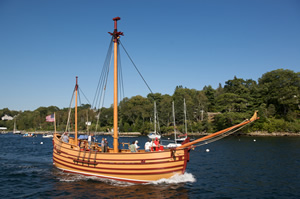 The ADVENTURE
The ADVENTURE
A reproduction of a 17th century coastal trader, the ADVENTURE was a cargo vessel that would carry supplies, provisions, commodities and livestock between New Amsterdam (present New York) and Barbados in the West Indies.
Considered the “seed colony”, or cultural hearth, of Carolina, Barbados
played a crucial role in the founding of Charles Towne.
One of the original Lords Proprietors, the eight English aristocrats upon whom King Charles II conferred the Carolina Charter in 1663, was a wealthy Barbadian planter named Sir John Colleton.
At the time of Charles Towne’s establishment, Barbados was the wealthiest English colony in the Americas, thanks to the wildly lucrative sugar industry. Hoping to turn a profit on their colonial enterprise, the Lords Proprietors looked to Barbados, with its slave-based plantation system devoted to the cultivation of a single cash crop, as an economic model for Carolina. They actively recruited Barbadians, placing a premium on their experience, and employed Barbadian sea captains to explore the Carolina coastline to find a suitable place for a settlement. Barbadian immigrants would constitute a significant portion of the colony’s population in the early years. Their leaders would form a powerful faction that would hold sway over South Carolina’s political affairs for decades. Using ketches like the Adventure, Barbadian and Carolinian merchants helped strengthen the ties between the two colonies, bringing sugar, rum, and manufactured goods to the mainland and taking badly needed timber products and foodstuffs back to a deforested island covered in seas of sugarcane.
Ancestors of Thomas OUTLAW The George-Powell Family
"Here lyeth the bodie of Thomas Outlaw of Cardeston Gent who died
15th May 1650". Cardeston is a 'lost' village close by.
"Kerdeston or Cardeston, cum Reepham"
Burgolion's Manor.
William Earl Warren had a lordship here, of which Godwina freeman, was deprived, (this was Earl Goodwin father of King Harold,) on whose death the Conqueror seized it, and Ralph held it at the survey, under the Earl
Warren
Kerdeston Manor.
Another lordship in this town was in Ralph Lord Bainard; of this, Tord, a freeman, was deprived at the
conquest, and Jeffrey Bainard held it under Ralph at the survey;
Sir James Boleyn of Blickling had also some interest here, granted to him by King Henry VIII. on March 22, in his 31st year, and had license in the 1st of Queen Mary, to alienate it to Edmund Lomner and Sir Thomas Paine; in Sir James's grant, the 2 manors of Kerdeston and Refham are mentioned; and in the 2d of Edward VI. Sir James manumised two villains for 8l.
On August 22d Queen Elizabeth, in her 28th year, granted to Ambrose Willoughby, Esq. the site of Kerdeston
manor, with lands; it was after in the Crown with the patronage of the
church.
Flickriver Most interesting photos tagged with littlewitchingham
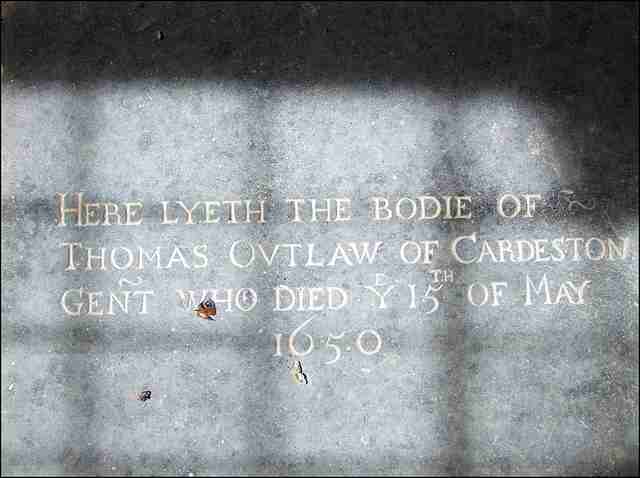
1613 - "The Visitation of Norfolk for 1613 - This
Visitation also includes John Outlawe of East Derham and Margery, his wife,
second daughter of William Walshe, by Olive, his second wife, and their
children as follows: John, Catherine, Joane, and Cecilly. (Harleian Soc.
-Vol. 32)"
Added material from 1563 Norfolk visitation to Excerpts of "Outlaw Genealogy" by Albert Timothy Outlaw.
Walshe Family :
Margaret nee Walshe married John Outlaw of Dereham and had four children:
John Outlaw, Catherine Outlaw, Joane Outlaw, Cecily Outlaw
Does this Cecily have anything do with this:? (TheWalshe family also had Cecily's so this is probably an homage to the wifes family...
But notice there is a John Outlawe (but no brother Edward) .
1279 - June 12 Rochester - Simple Protection, for three years, for David de Pembrok, and Cecil[ia] la Utlaghe - Kings Writ - 7 Edward I - (Every indication is that Cecilia Utlaghe was from Ireland along with David de Pembrok and in England for schooling ) Earliest record of an Utlaghe from Ireland !
The Ireland connection:
County Kilkenny Surname Histories
Walsh - Walsh is among the five most numerous surnames in Ireland, found throughout the country. There are concentrations of Walshes in Leinster in counties Kilkenny and Wexford, in Connacht in counties Mayo and Galway, and in Munster in counties Cork and Waterford.
Walsh is a semi-translation of the Irish surname Breathnach, meaning 'Welsh' or
'Breton', also sometimes anglicised as 'Brannagh'. This alludes to a Cambro-Gaelic origin of the Walsh
families. 'Philip of Wales', a hero in a naval battle of 1174, is thought to be an ancestor of the Walshs in the Mountains of south-central County Kilkenny. Lawrence Walsh compiled a genealogy in 1588 and claimed the Walshs of the Mountains, among other
Walsh families, were descended from Walynus, a Welshman who came to Ireland with Maurice Fitzgerald in
1169. The leading members of this family established themselves as landed gentry at Castlehowel (Co. Kilkenny), at Ballykileavan (Co. Leix), at Ballyrichmore (Co. Waterford) and also at Bray and Carrickmines near Dublin.
...
For early history on the Walshs, see Walsh Family Genealogy and History.
Walsh, Walshe, Welsh (et al) of England
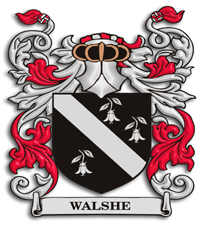
Colbye
The arms of Walshe of Colbye are described in a pedigree published in the
The visitacion of Norffolk (Harleian Society, v. 32, 1891). The
description is 'Sable, a bend between three lilies (columbines?) slipped
and leaved argent.'
The head of the family in this pedigree was Thomas Walshe, whose
children included Robert, Roger, Jefferey, Joane, and Cecilly. The
remaining portion of the pedigree focuses on Robert Walshe, son of Thomas,
who was born perhaps before 1451. He married Cecilly Harsyck, daughter of
Sir John Harsyck, and their sons included a Robert and William Walshe.
Another description of the Walshe arms are given as "Sable, a bend
between three lilies, Argent, stalked vert." These were the quarterings
of Sir Andrew Fountaine, knight, in 1725, and are quartered with Walshe, Harsick,
Damme, Briggs and Beaupre. [source: An essay towards a topographical history of
the county of Norfolk, 1807]
William Walshe son of Robert and Cecilly, born in the latter half of the 15th
century, was married three times.
By his first wife, Margaret, dau. and heir of Simon Dane [Damme] of Susted in
Norfolk, their children included Robert, Ella (m. three times) and Elizabeth (m.
Arthur? Fountayne & Richard Stone).
By his second wife, Olive, daughter of Robert? Clere of Stokesby in Norfolk,
they had children named William, Margery (m. John Owtlawe of Est Derham),
Ursula (m. John Colbye) and Elizabeth (m. Robert Clarke).
By his third wife, Ann, dau. and heir of Robert Kebyll of Felmingham in Norfolk,
their daughters included Margery (m. William Russell & Robert Gabyn) and
Elizabeth (m. Thomas Bulwer of Wood Dalling).
NOTE: a second pedigree (ibid.) suggests that Elizabeth, dau. of
William and Margaret (Dane or Dame) Walshe, was married to Mathew Fountayne of
Salle in Norfolk. Among their children included Arthur (the heir), George and
Elizabeth. [source: An essay towards a topographical history of the county of
Norfolk, 1807]
William Walshe, the younger, of Colbye in Norfolk, son and heir of William and
Olive (Clere) Walshe, was married twice. His first marriage was to Bridget, dau.
of Rob. Thymblethorpe of Worsted in Norfolk. William married second, Ann, dau.
of Sir James Framyngham in Suffolk, knight. A daughter of William and Ann was
named Elizabeth
Norfolk Churches - St Giles, Colby
A brass at Colby Church commemmorates Thomas Williach or Walysh and
Margaret his wife of Colby and Antingham. Will 1452.
[Norfolk Archaeology; v. 32; 1961]
Two other inscriptions commemorate members of the same family but in different
churches: one at Colby commemorates Thomas Walsh (d.1451) and Margaret his
wife (d. 1494); the other at Blickling commemorates Roger Walsh (d.
1499). [source: Church Monuments in Norfolk Before 1850: An
Archaeology of Commemoration; Jonathan Finch; 2000]
An inscription for Thomas and Margaret Walsh, Colby, Norfolk, dated 1494. And
an inscription for Robert and Margery Walsh, Colby, Norfolk, dated 1503.
[source: Norfolk Archaeology, v. 26; 1938]
Norfolk
Churches - St Andrew, Blickling - The brasses are a reminder of Blickling's association with one of the great tragic figures of English history before its rebuilding; several are to the Boleyn family, and Anne Boleyn, second wife of Henry VIII, grew up
here. The Felthorpe family is depicted in its entirety, with eleven sons and five daughters. Most moving is Anne
Wode, who carries her two dead babies in her arms. The best are, perhaps, the smaller figures, although the lifesize Sir Nicholas Dagworth is rather fine.
...
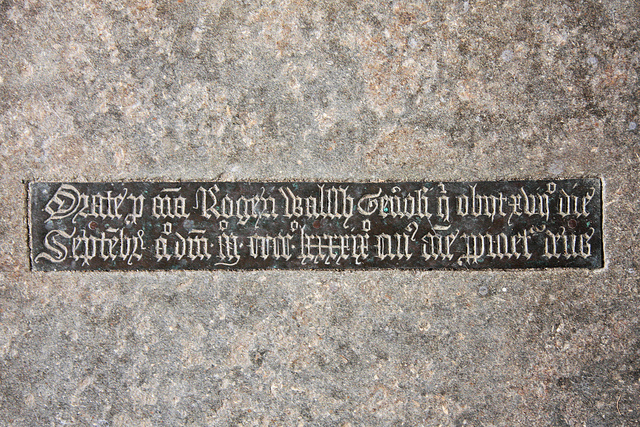 Brass
inscription to 1499, - Roger Walsh, Blickling St Andrew Church, Norfolk
Brass
inscription to 1499, - Roger Walsh, Blickling St Andrew Church, Norfolk
Orate pro anima Rogeri Walsh, Benerosi, qui obiit rbii die Septemb' Anno Dni. Moccccolxxxxix. cuius anime propicietur Deus.
The inscription is to Roger Walssh, generosi (gentleman) who died in 17th day of September 1499
1533 - London and Middlesex Fines: Henry VIII - Adam Owtlawe, 'maryner' - St. Mary Matfelon - Easter Anno 25 1533
Thomas Warner, of London, draper, and Agnes, his wife, Thomas Darnewell, gentleman, Thomas Mayhew, Thomas
Raynold, 'clothwerker,' Hugh Cherche, 'wodmonger,' Adam Owtlawe, 'maryner,' and Robert
Hookynngs, 'talowchaundeler,' and William Goddard, merchant of the staple of Calais, and Elizabeth, his wife.
Premises in the parish of St. Mary Matfelon. Easter Anno 25.
St Mary Matfelon - church, popularly known as St Mary's, Whitechapel, was an Anglican church in Whitechapel, London. It was situated on Whitechapel Road.
For over 600 years a Christian church stood on the site of Adler Street,
White Church Lane and Whitechapel High Street, London E1. The original church
known as the Whitechapel Church, St Mary Matfelon was the second oldest church
in Stepney after St
Dunstan's Church. It was created as a chapel-of-ease for the local area
and was built in the 14th century in 1329. In 1673, the parish of Stepney was
divided into nine separate parishes, one of them being the newly formed parish
of St. Mary's, Whitechapel.
...
Whitewash made of lime and chalk was used as a paint on the outside of the
original church in the Middle Ages which gave it a bright white finish,
prompting the locals to call it the 'white chapel'. The
...
This church is of some antiquity, as appears by Hugh de Fulbourn being rector
thereof in the year 1329. It was originally a chapel of ease to the church of
St. Dunstan, Stepney, and is supposed to have obtained the epithet of White from
having been white-washed or plastered on the outside.
The first church erected on the spot after it ceased to be a chapel of ease of
Stepney parish, was dedicated to St. Mary Matfelon; a name which has given birth
to many conjectures respecting its signification, but which is probably derived
from the Hebrew word Matfel, which signifies both a woman lately delivered of a
son, and a woman carrying her infant son; either of which significations is
applicable to the Virgin Mary and her holy babe.
The old church being in a very ruinous condition, it was taken down in 1673, and
the present edifice was soon after erected in its stead.
...
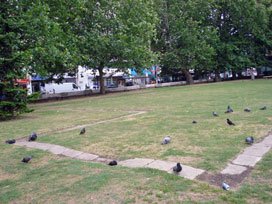 diamond geezer
- Altab
Ali Park. It's named after the young
Bangladeshi victim of a racial murder back in 1978, remembered through a
wrought iron gateway at the entrance to the park [photo].
In one corner is the Bengali Martyr's Monument [photo],
simplistically Japanese in style, though these days more a convenient spot to
sit and swig cheap lager. The grass is patchy and covered with pigeons,
and the whole place has the feel of somewhere frequented by those with nowhere
better to go. But look more carefully and there's the stone outline of a large
church laid out in the turf, and a handful of gravestones in the corner. It
turns out that this park is the churchyard of medieval St
Mary Matfelon,
the original "white chapel" after which the local area is named.
The church was rebuilt several times over the centuries - taller, grander,
spire-ier - until bomb damage during the Blitz obliterated it forever. St Mary's
lives on now only in name, and as somewhere for incoherent alcoholics to
congregate while their mangy dogs squat in the nave.
diamond geezer
- Altab
Ali Park. It's named after the young
Bangladeshi victim of a racial murder back in 1978, remembered through a
wrought iron gateway at the entrance to the park [photo].
In one corner is the Bengali Martyr's Monument [photo],
simplistically Japanese in style, though these days more a convenient spot to
sit and swig cheap lager. The grass is patchy and covered with pigeons,
and the whole place has the feel of somewhere frequented by those with nowhere
better to go. But look more carefully and there's the stone outline of a large
church laid out in the turf, and a handful of gravestones in the corner. It
turns out that this park is the churchyard of medieval St
Mary Matfelon,
the original "white chapel" after which the local area is named.
The church was rebuilt several times over the centuries - taller, grander,
spire-ier - until bomb damage during the Blitz obliterated it forever. St Mary's
lives on now only in name, and as somewhere for incoherent alcoholics to
congregate while their mangy dogs squat in the nave.
More found on Thomas Outlawe of London in the late 1490's early 1500's:
1493 - Inquisition taken at the Guildhall - London, 23 March, 8 Henry VII [1493], before William Martyn, Mayor and escheator, after the death of Edward Greene, by the oath of John Machyn, Thomas Outlawe, John Gage, Thomas Couper, William Wodestok, Henry Calvar, Thomas Rayner, Thomas Lybbys, Nicholas Jefray, William Cambre, Richard Spycer, John Broune, John Knyght, Thomas Chamberleyn, and Richard William - GUILDHALL London - Guildhall, London
1493 - Death of Ellen Wodeward witnessed by Thomas Outlawe - London - 23 March, 8 Henry VII
(Ellen Woodward.
Inquisition taken at the Guildhall, 23 March, 8 Henry VII [1493], before William Martyn, Mayor and escheator, after the death of Ellen Wodeward, widow, by the oath of John Machyn, Thomas Outlawe, John Gage, Thomas Couper, William Wodestok, Henry Calvore, Thomas Reyner, Thomas Lybbys, Nicholas Jeffrey, William Cambre, Richard Spicer, John Broune, John Knyght, Thomas Chamberleyn, and Richard William, who say that
John Wodeward and the said Ellen, his wife, were seised of 24 messuages situate within the parish of All Saints of Berkyng, and so seised they enfeoffed thereof Thomas Chicheley, son of the said Ellen: to hold to him and his heirs for ever. The saidThomas Chicheley still survives, and is seised of the premises as of freehold.
The said premises are held of James Underwode, Master of Whitingdon College in the City of London, but by what service the jurors know not; they are worth per ann., clear, 5 marks.
Ellen Wodeward died 1 July, 6 Henry VII [1491]; John Chicheley is her son and next heir, and is aged 40 years and more.
Inq. p. m. 8 Henry VII, No. 103.
The name of Ellen Woodward's former husband is not given in the inquisition, but from the calendar it appears to have been Simon Checheley.
| -
1497 - Death of Richard Chamberleyn witnessed by Thomas Outlawe - London - 4 March, 12 Henry VII - 1497
1508 - Death of Henry Frowyk - witnessed by Thomas Outlawe - London - 20 May, 23 Henry VII [1508]
1593 - To Ric. Owtlaw, pursyvaunt, for arestinge Mr. Arch deacon of York in the church of York upon a tachment - ** A singular incident. The Archdeacon of York, Robert Ramsden, a notorious person, has a writ served upon him in the minster at the suit of the Chapter
Robert Ramsden, Archdeacon of York and chaplain to Lord Burghley - William Cecil
William Cecil, 1st Baron Burghley - died 4 August 1598) was an English statesman, the chief advisor of Queen Elizabeth I
Henry Savile (Bible translator) - He was the son of Henry Savile of Bradley, near Halifax in Yorkshire, England, a member of an old county family, the Saviles of Methley, and of his wife Elizabeth, daughter of Robert Ramsden.... In 1578 he travelled on the continent of Europe, where he collected manuscripts and is said to have been employed by Queen Elizabeth as her resident in the Low Countries.
On his return he was named Greek Tutor to the Queen, and in 1585 was established as Warden of Merton by a vigorous exercise of the interest of Lord Burghley and Secretary Walsingham.
On 26 May 1596 he obtained the provostship of Eton, the reward of persistent begging...
In February 1601 he was put under arrest on suspicion of having been concerned in the rebellion of the Earl of Essex. He was soon released and his friendship with the faction of Essex went far to gain him the favour of James I.
1563 - Outlaw, of Wichingham - a saltier between 4 wolves' heads - erased gules - Coat Armour used in Norfolk Before 1563
I have included the names of the gentry of 1433, given by Fuller, and a similar list for 1500 given by Mason (vol. i., p. 110, from Coxe's
U MSS. British Museum 155, fol. 365), and of the High Sheriffs, for all these no doubt bore arms, though they have not come down to us.
...
I have thought it best to restrict my list to all coats proved to have been borne in the county before the first Herald's Visitation
of 1563. It may be asked why I did not include the arms borne at such visitation, but I have more than a suspicion that the heralds ! granted many new Coats at such visitation
[in 1563]
...
Outlaw, of Wichingham. Arg., a saltier between 4 wolves' heads
erased gu. (B 290) (viii., p. 373)
[ Gules means red in heraldry - erased? it is sometimes
depicted as a region of vertical lines or else marked with gu. as
an abbreviation - Erased = torn off, leaving a jagged edge ]
It may be interesting to close this part with a list of the 48 canting arms among the 1,344 coats mentioned in the foregoing: —
[ Canting arms - are heraldic bearings that represent the bearer's name in a visual pun or rebus ]
...
Outlaw ... ... Wolves' heads. [ Pun - An Outlaw is like a Wolf's Head ]
The foregoing list has about 1,617 entries. I included in it all those named in the two Lists of Gentry of 1433 and 1500, as printed by Fuller and Mason, on the assumption that anyone who was described as a gentleman at these dates was probably entitled to bear arms, and that as my work progressed I should be able to find out what such arms were.
As to this I find I was wrong, for of the 379 odd names in the 1433 list I can only guess at arms for about a quarter of them.
Nearly all in the 1500 list are of men we know were armigerous.
Consequently I have come to the conclusion (which I am glad to say is shared by the Rev. G. H. Holley) that the 1433 list was not made up of the actual gentry, but should have been rather styled a list of the more important citizens and others as well as of the gentry. This view is borne out by the fact that I find it includes the names of many local mayors, sheriffs, bailiffs, and other officials.
---- >>> Back to Outlawe Research Journal - Page 1 < - - - - - -----> Page 3